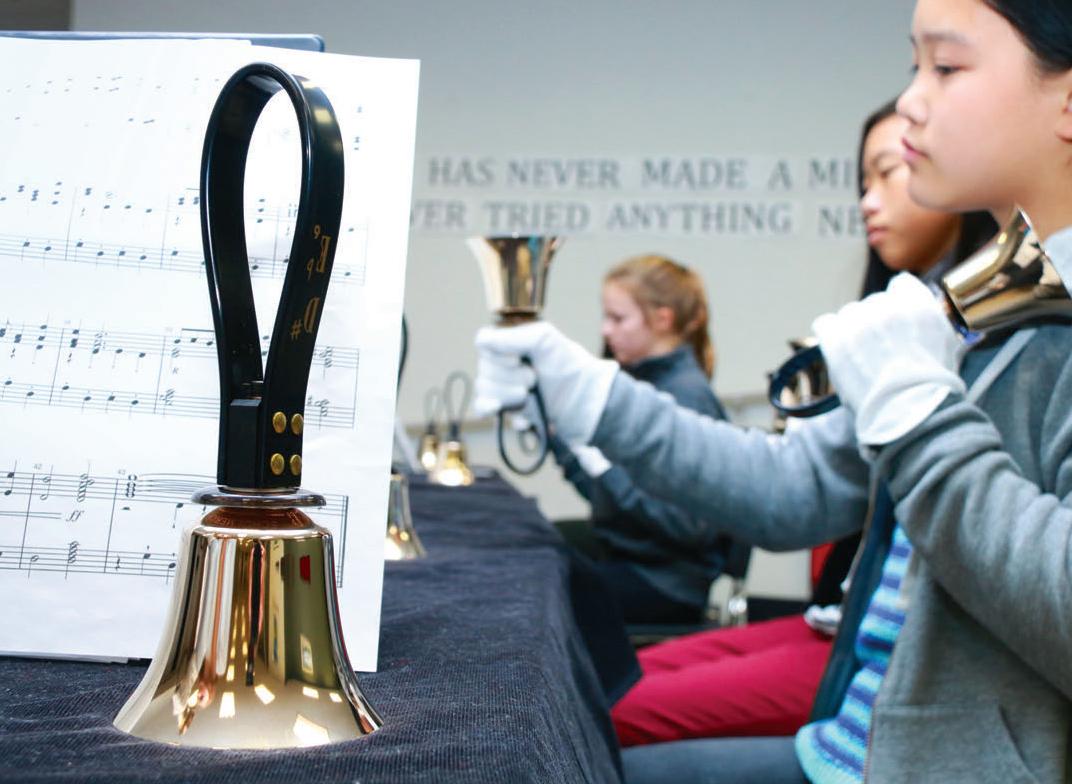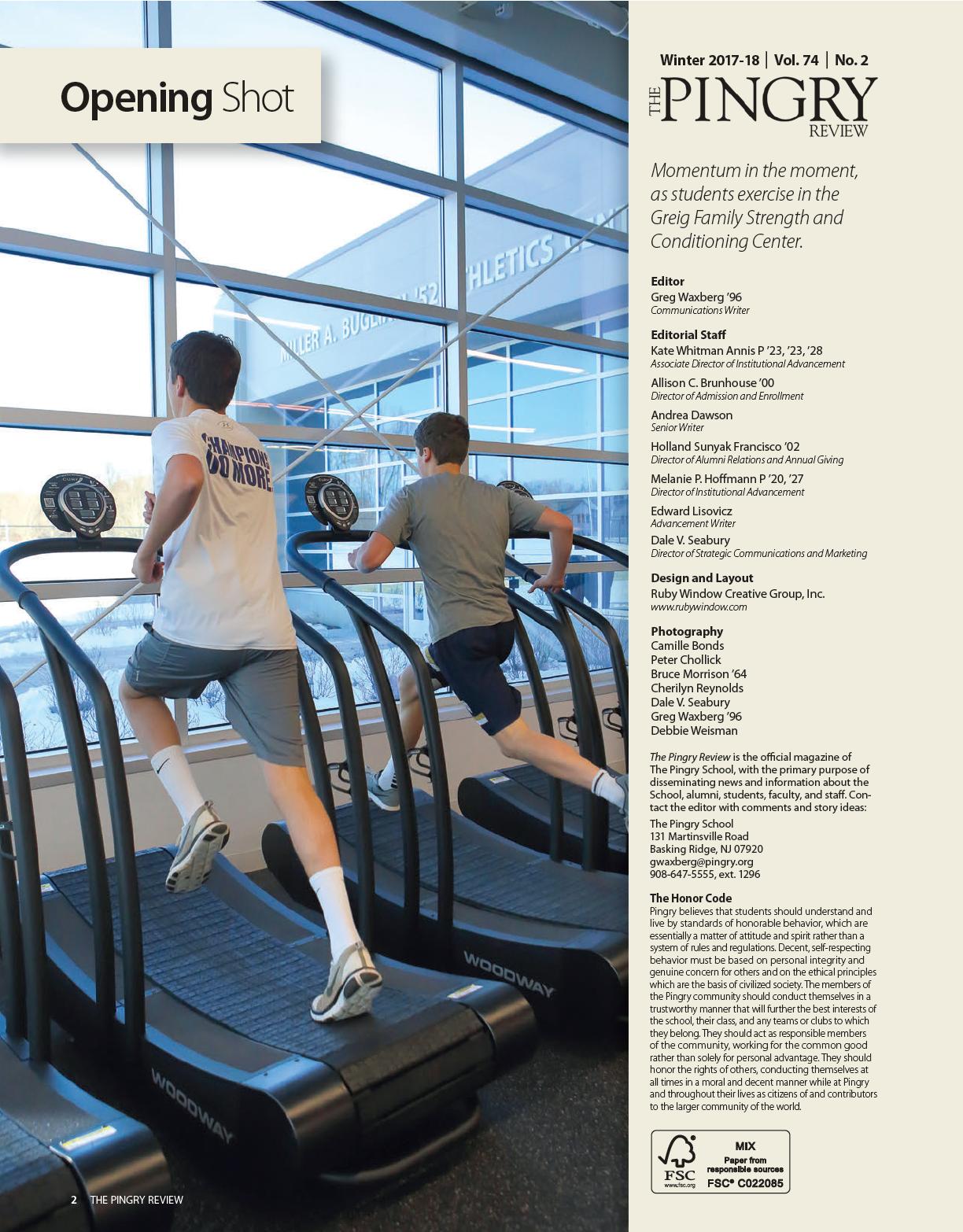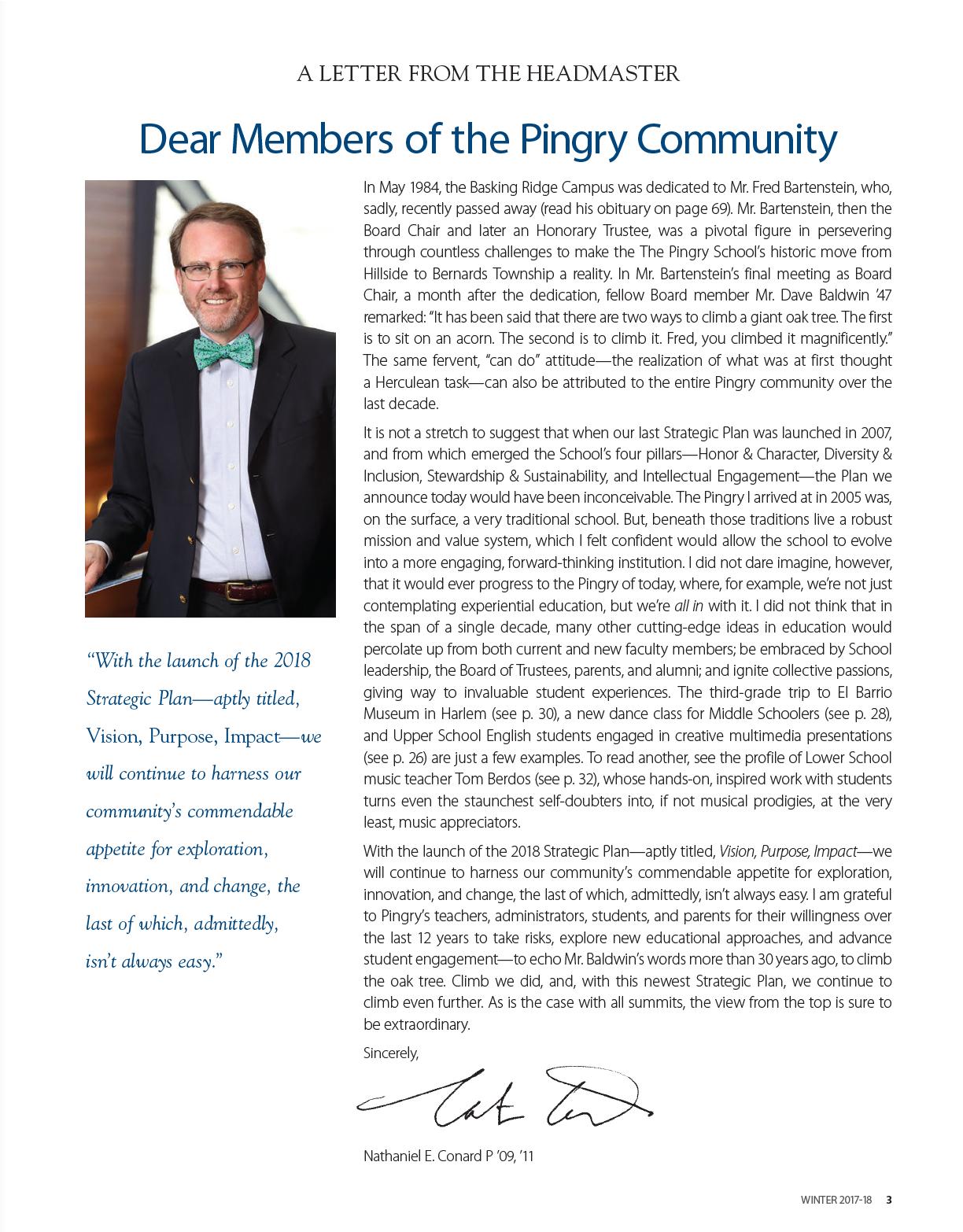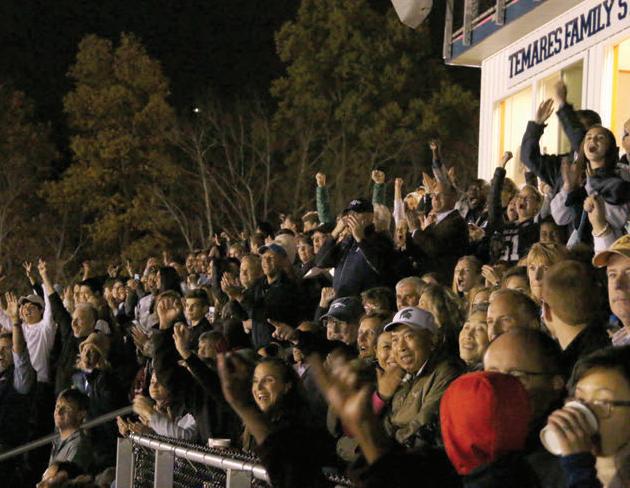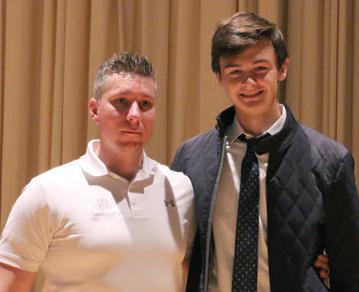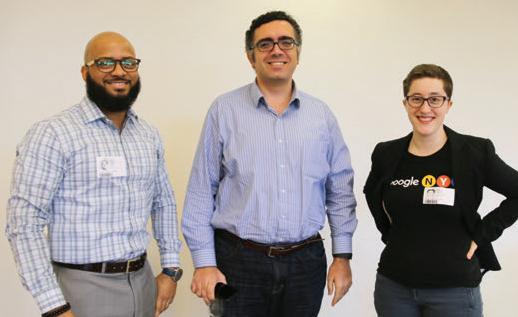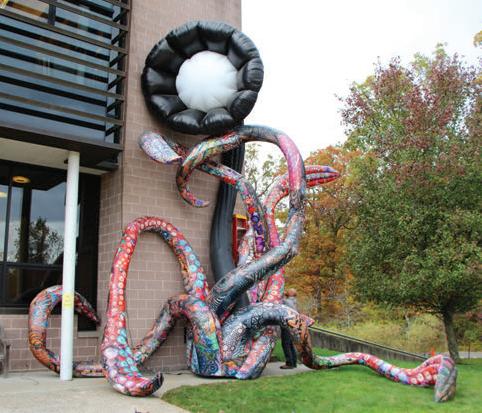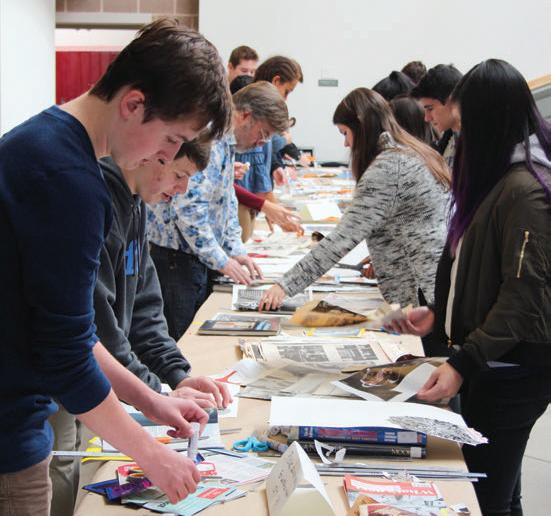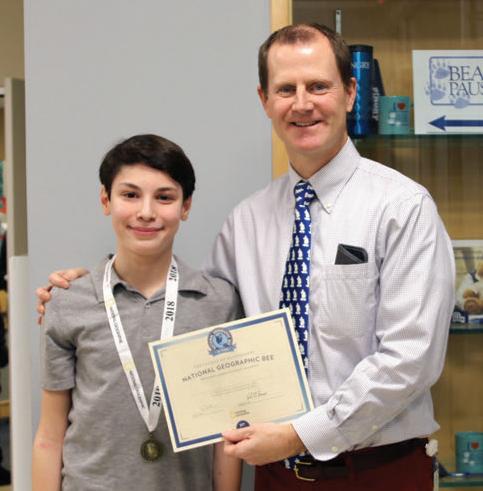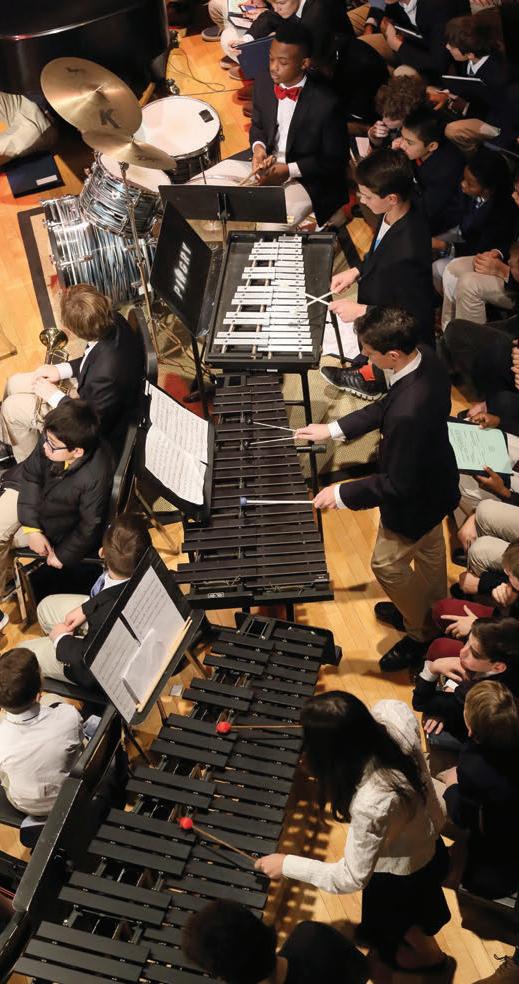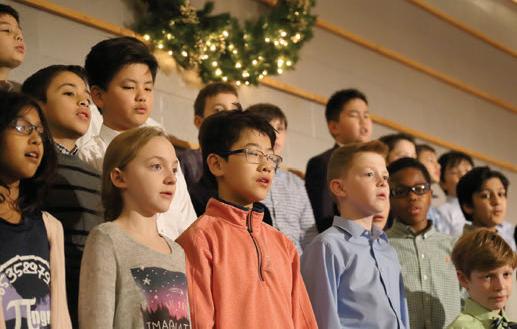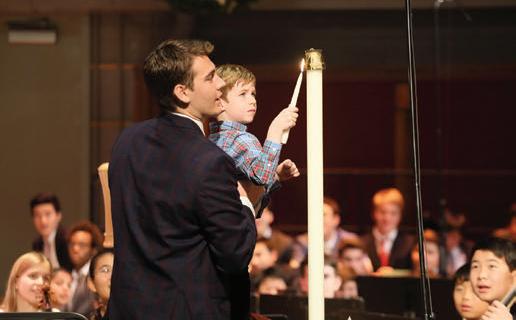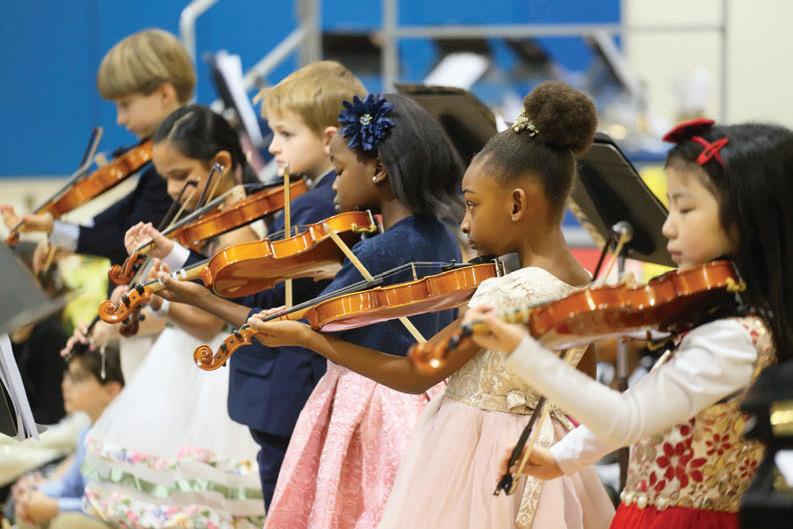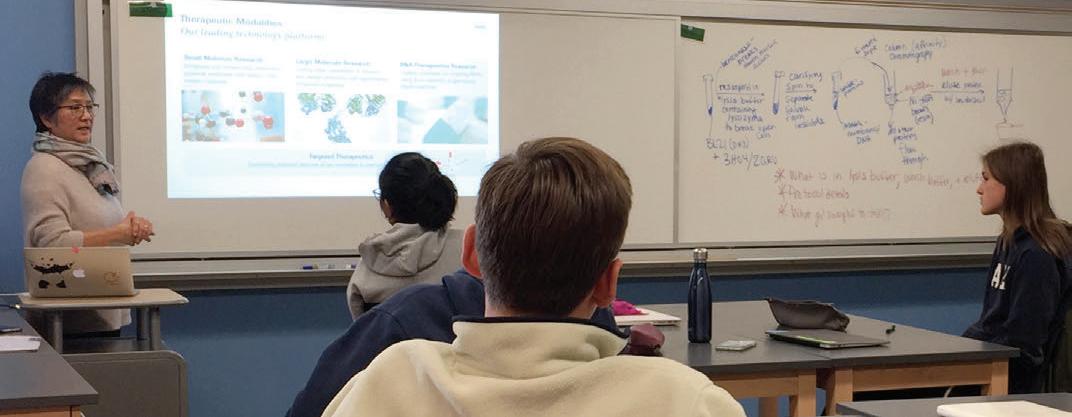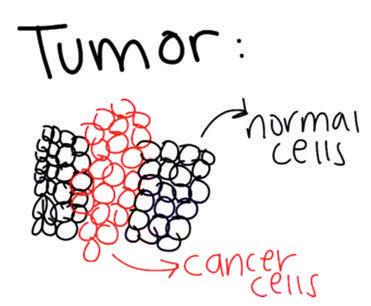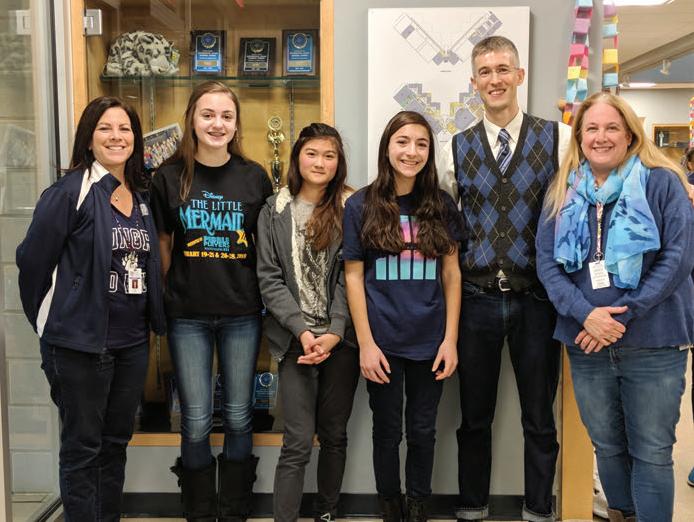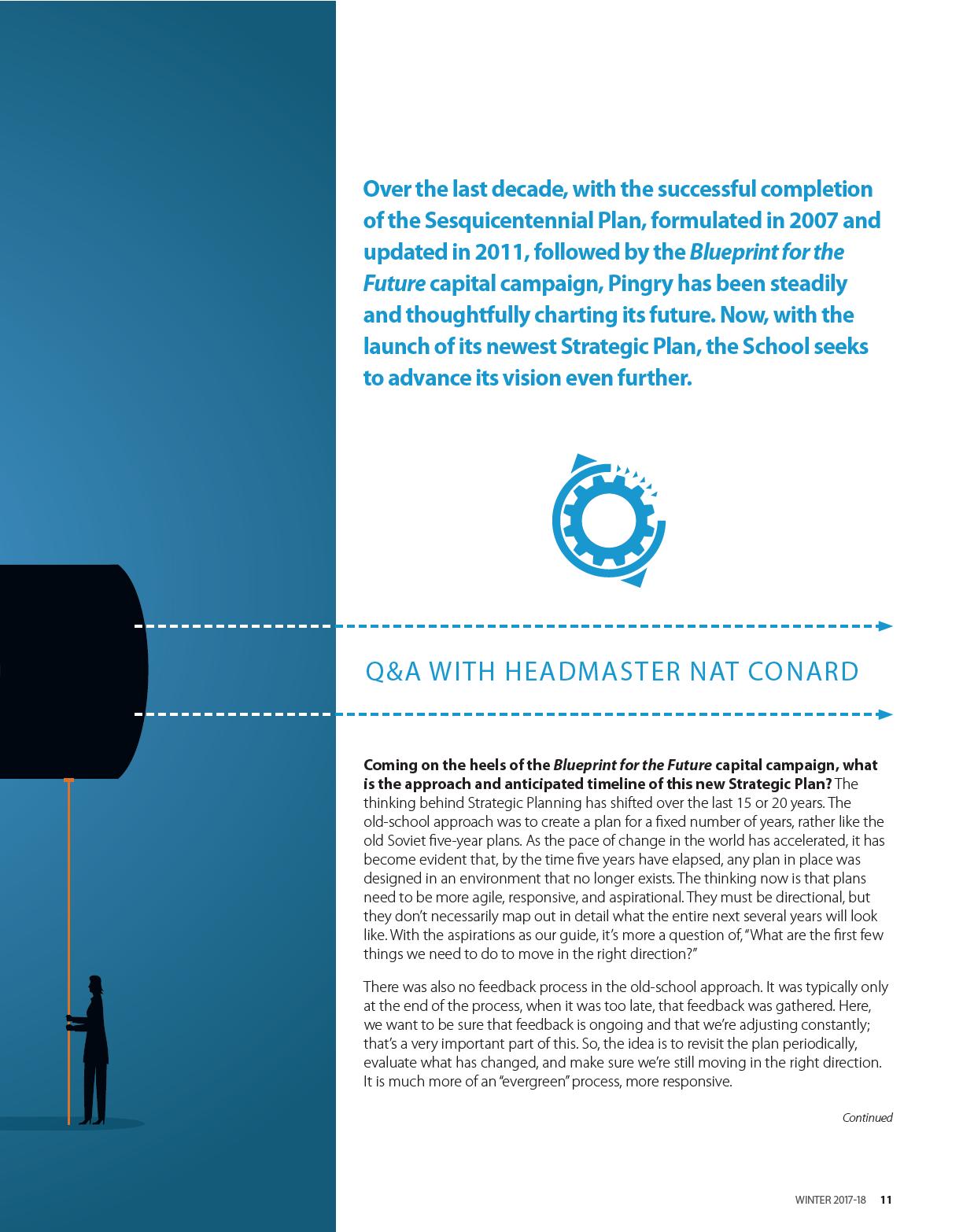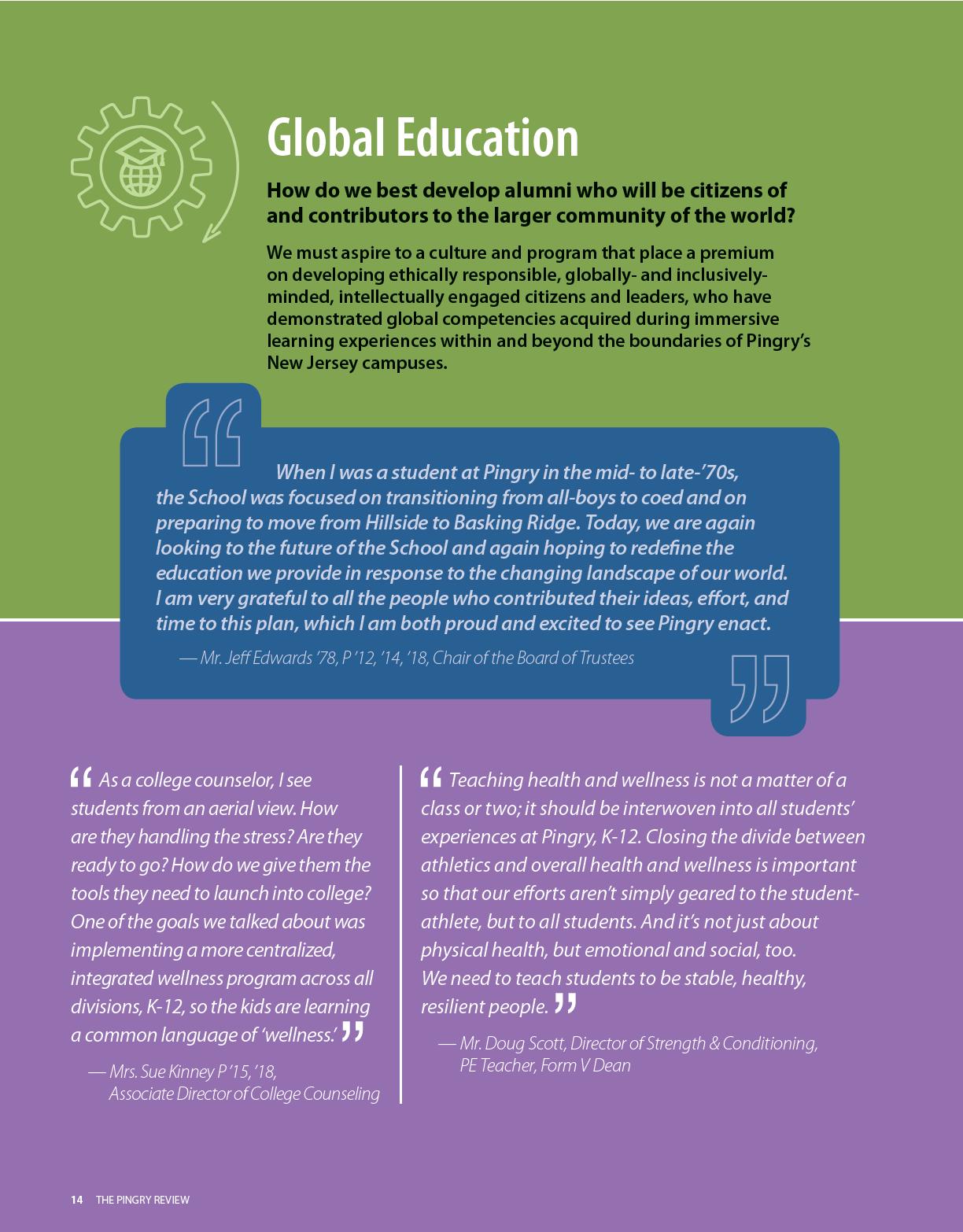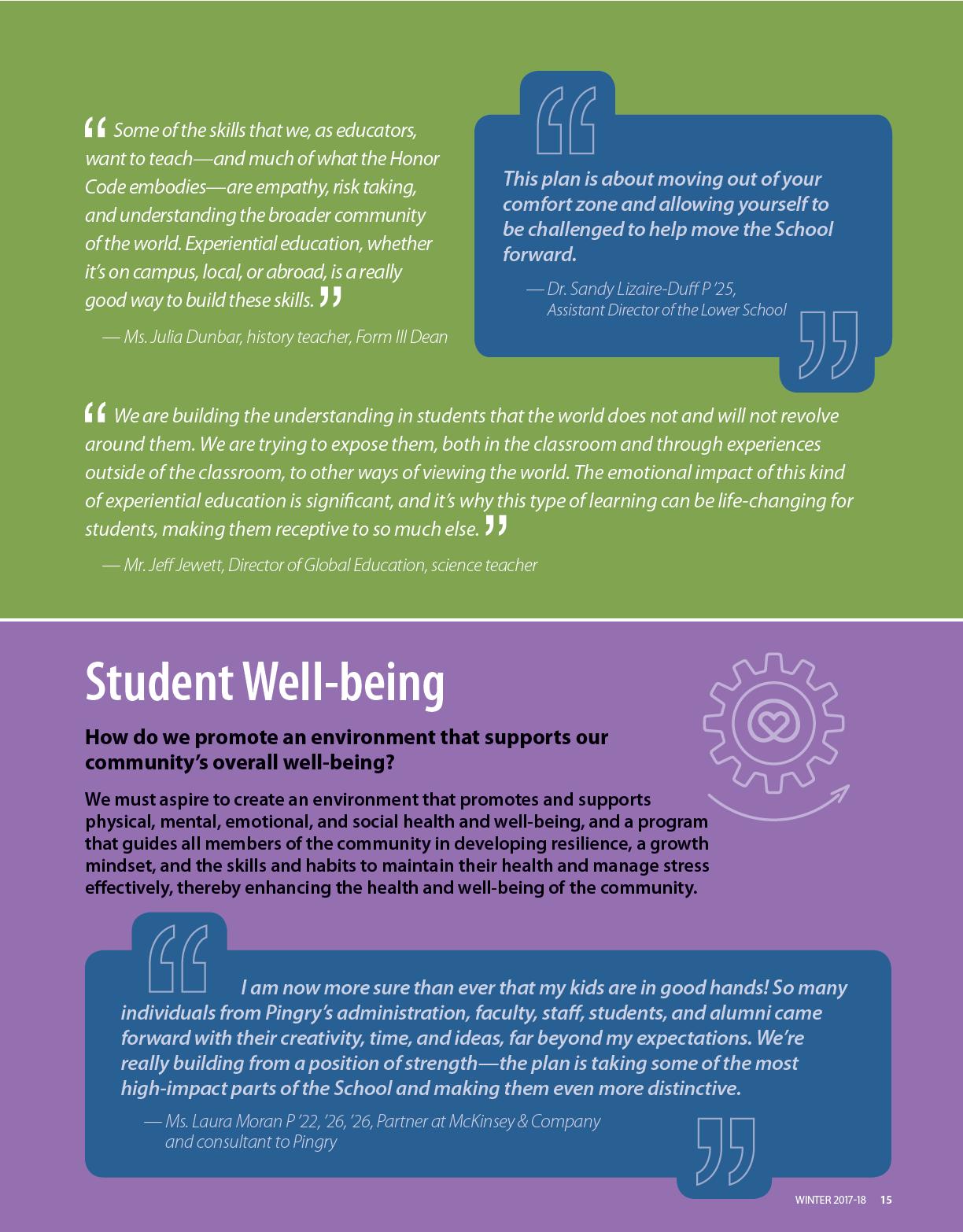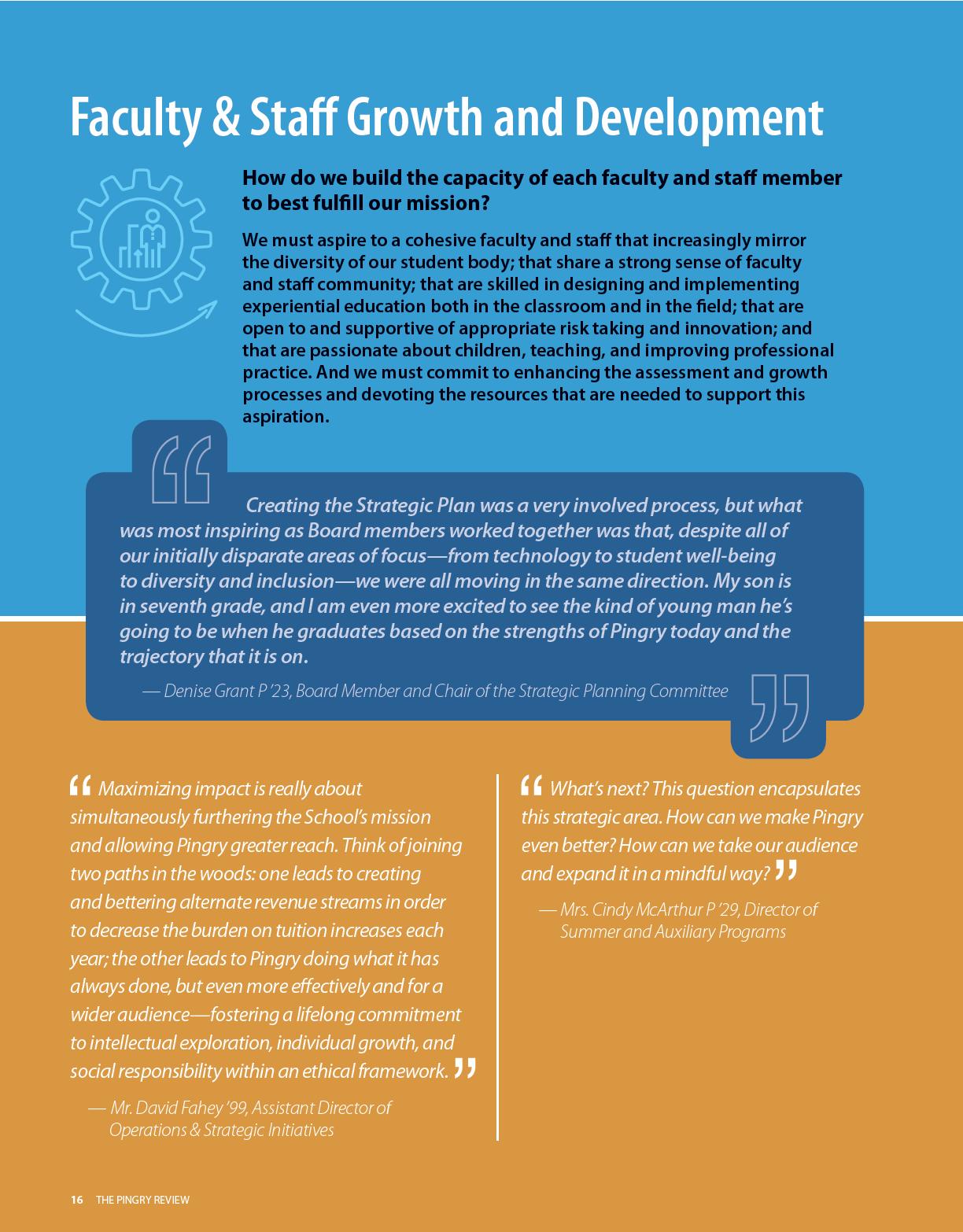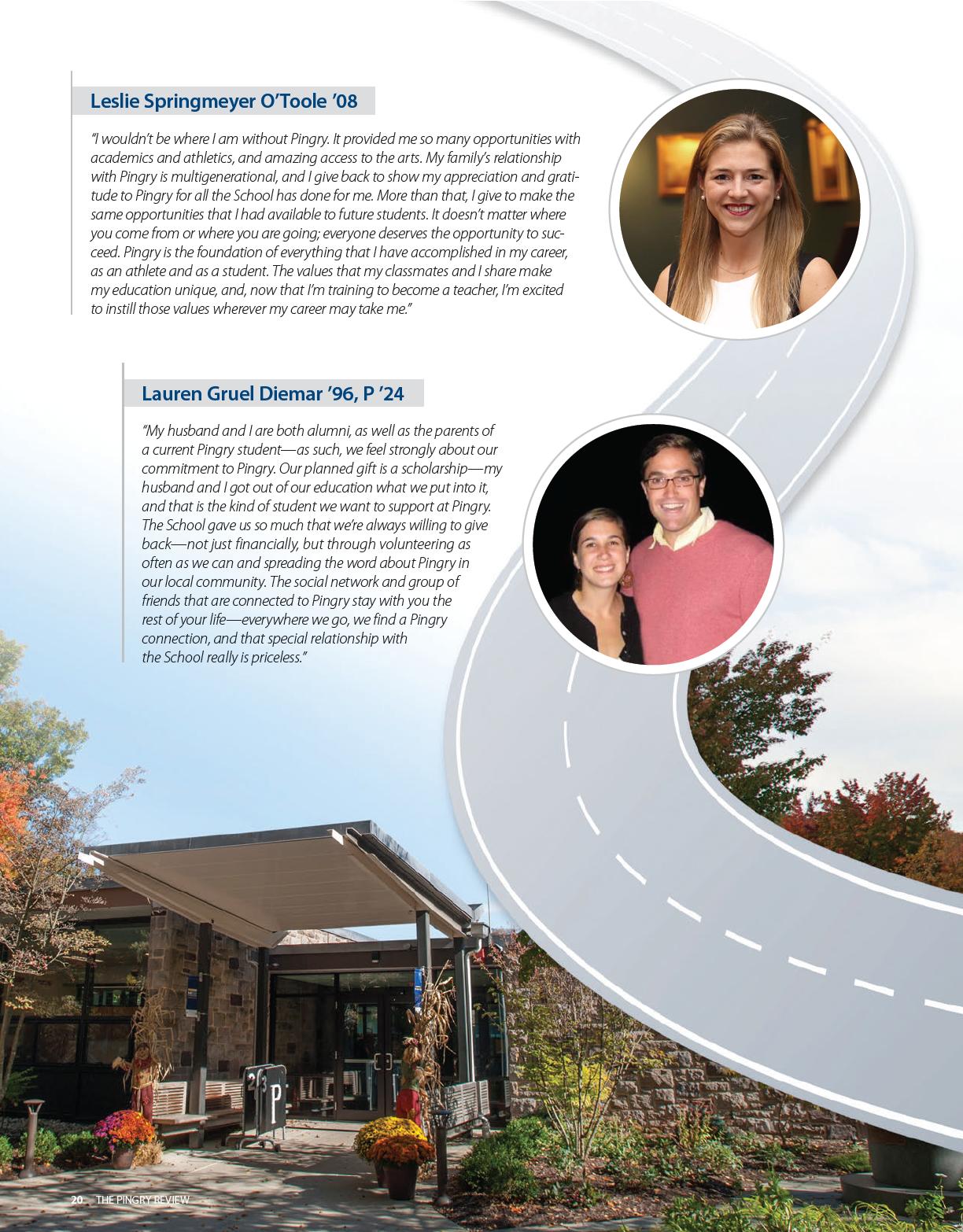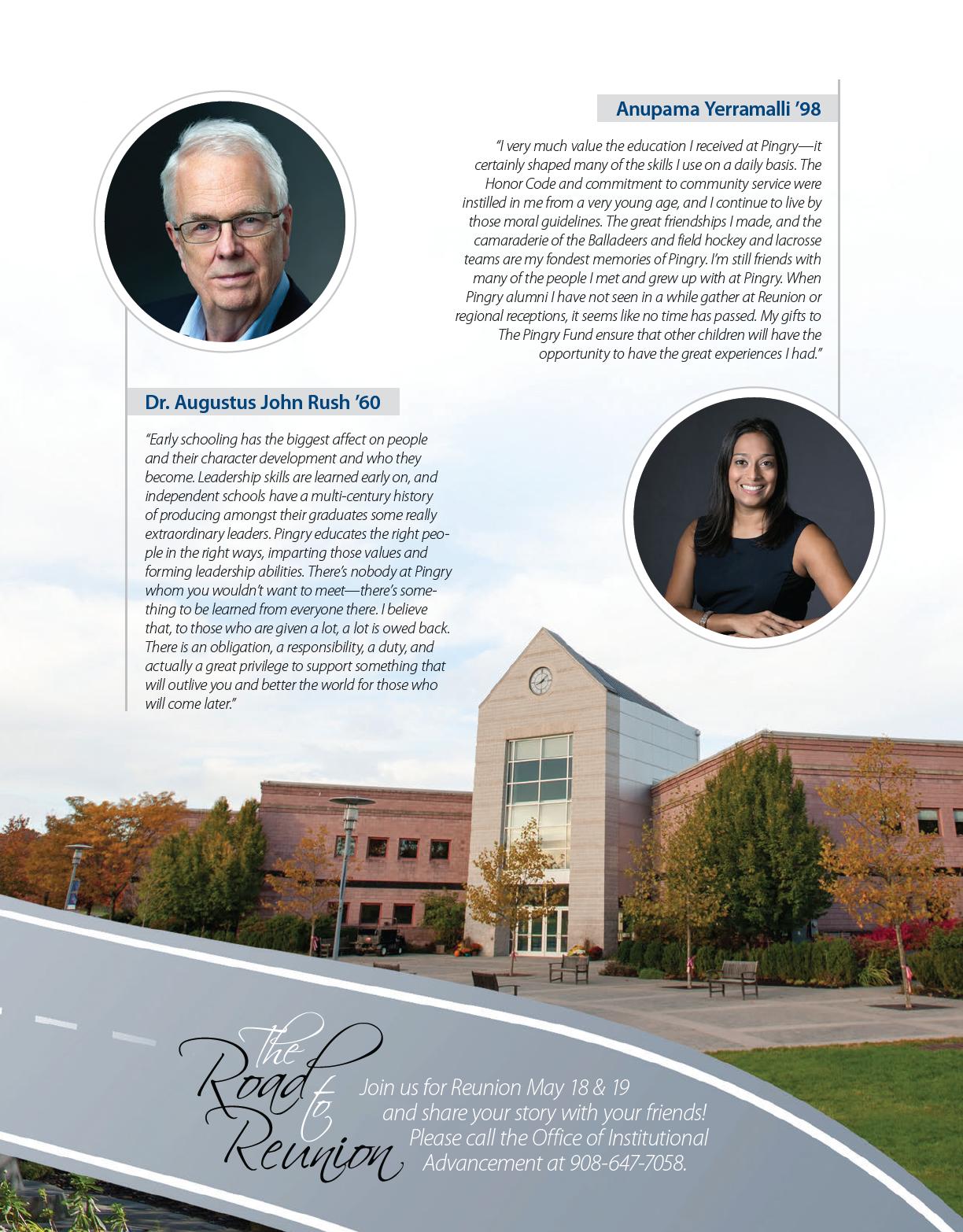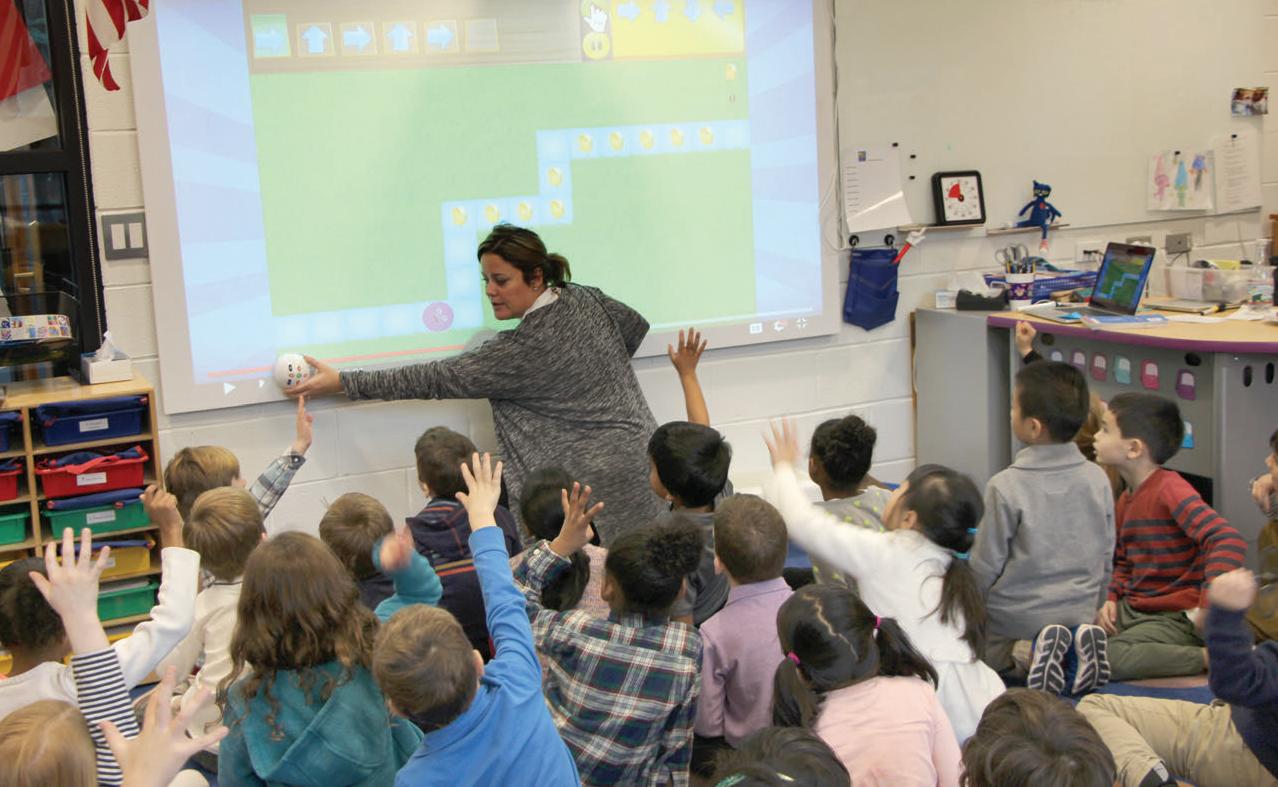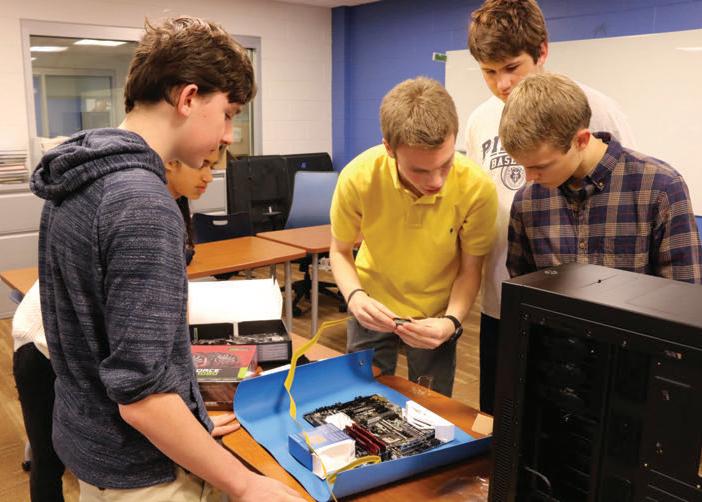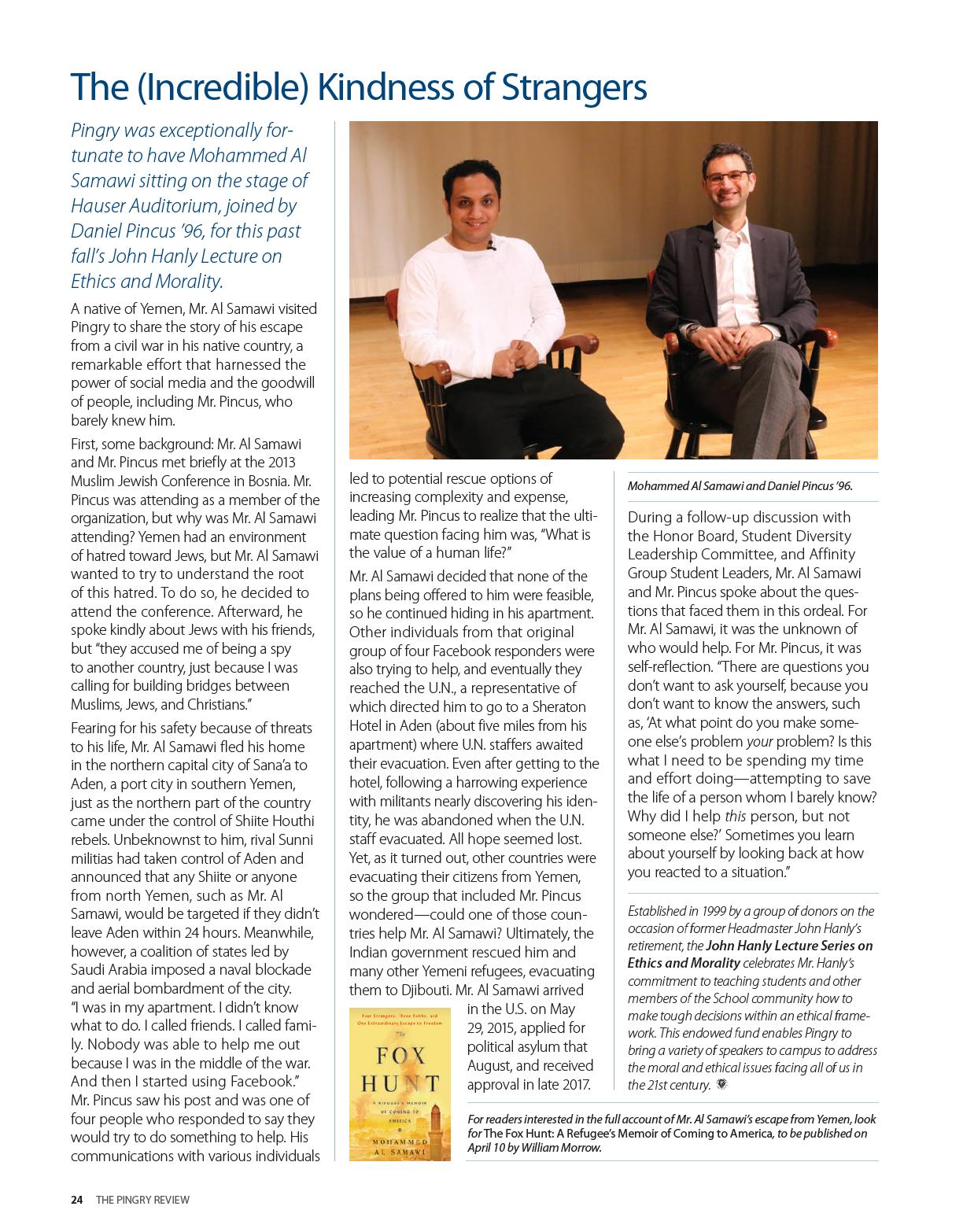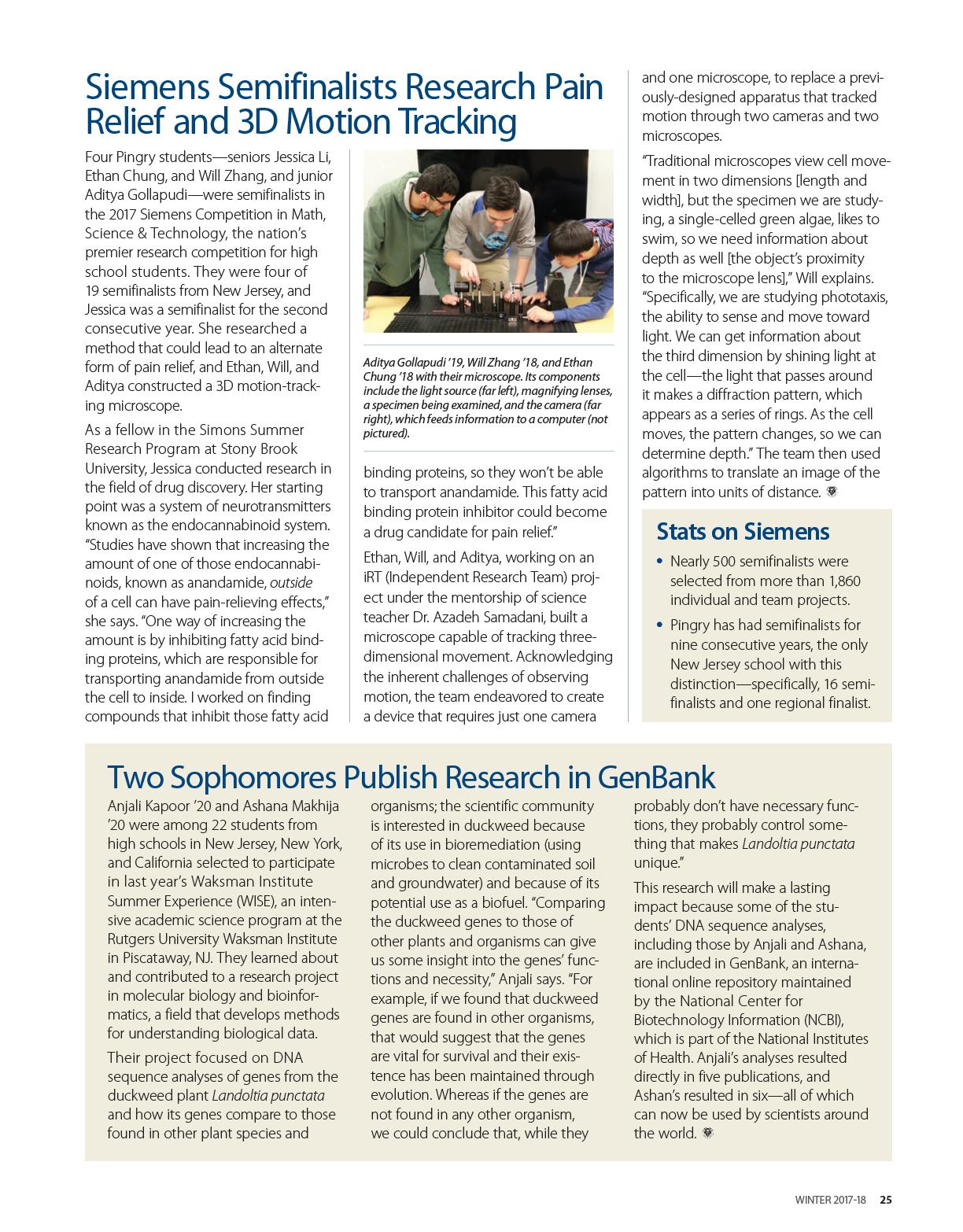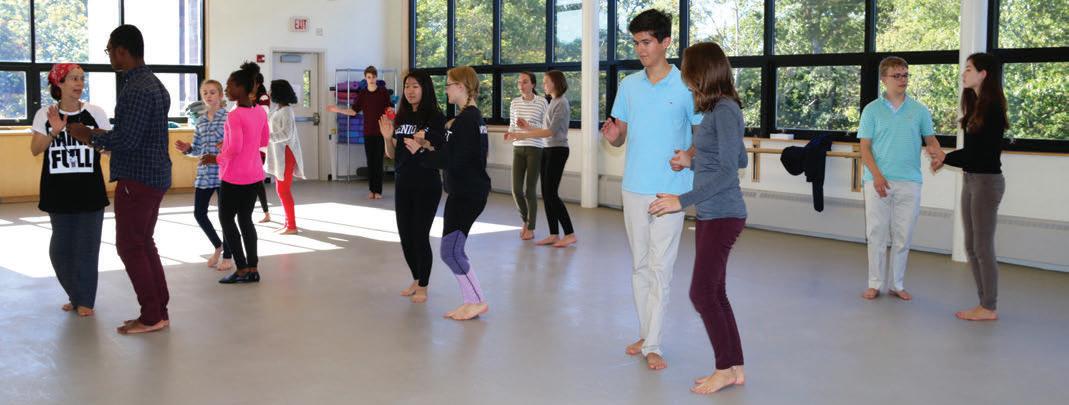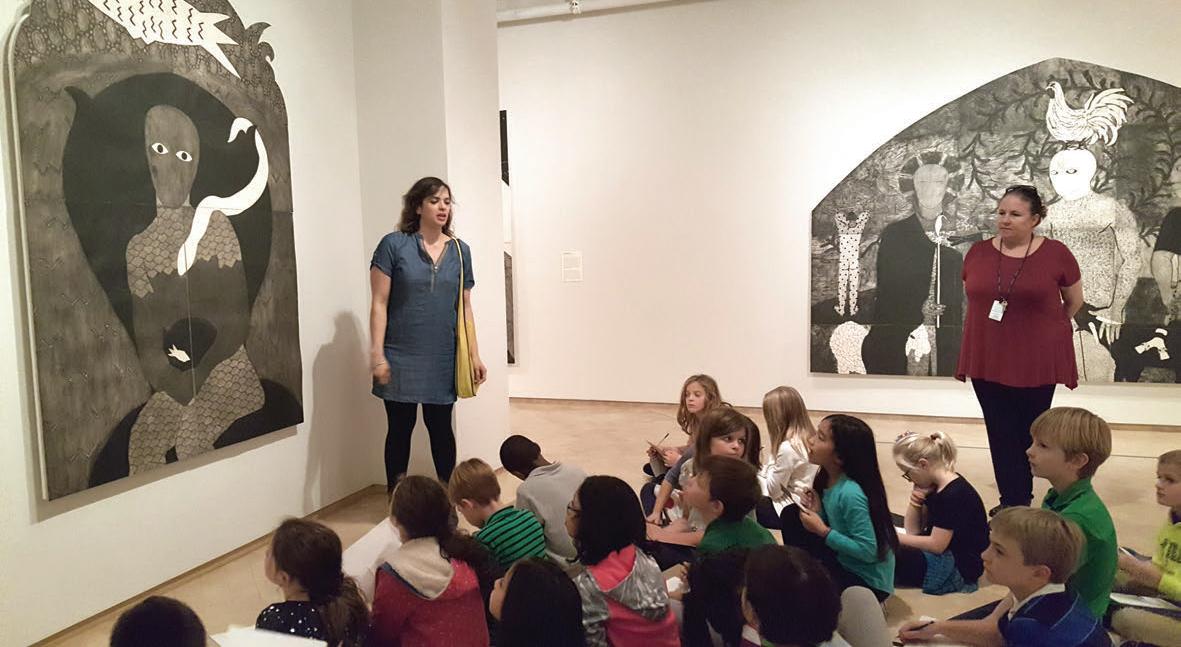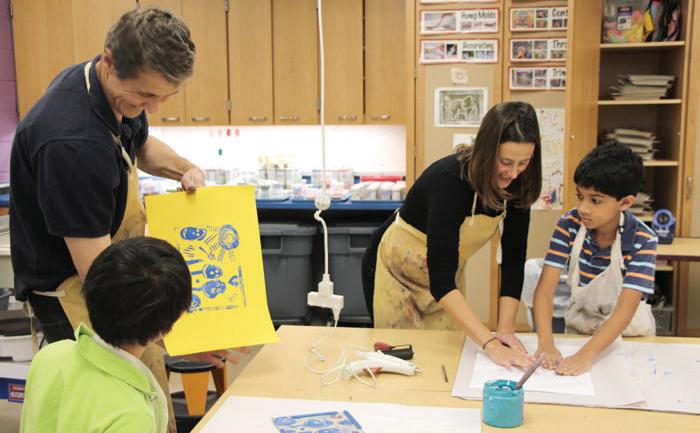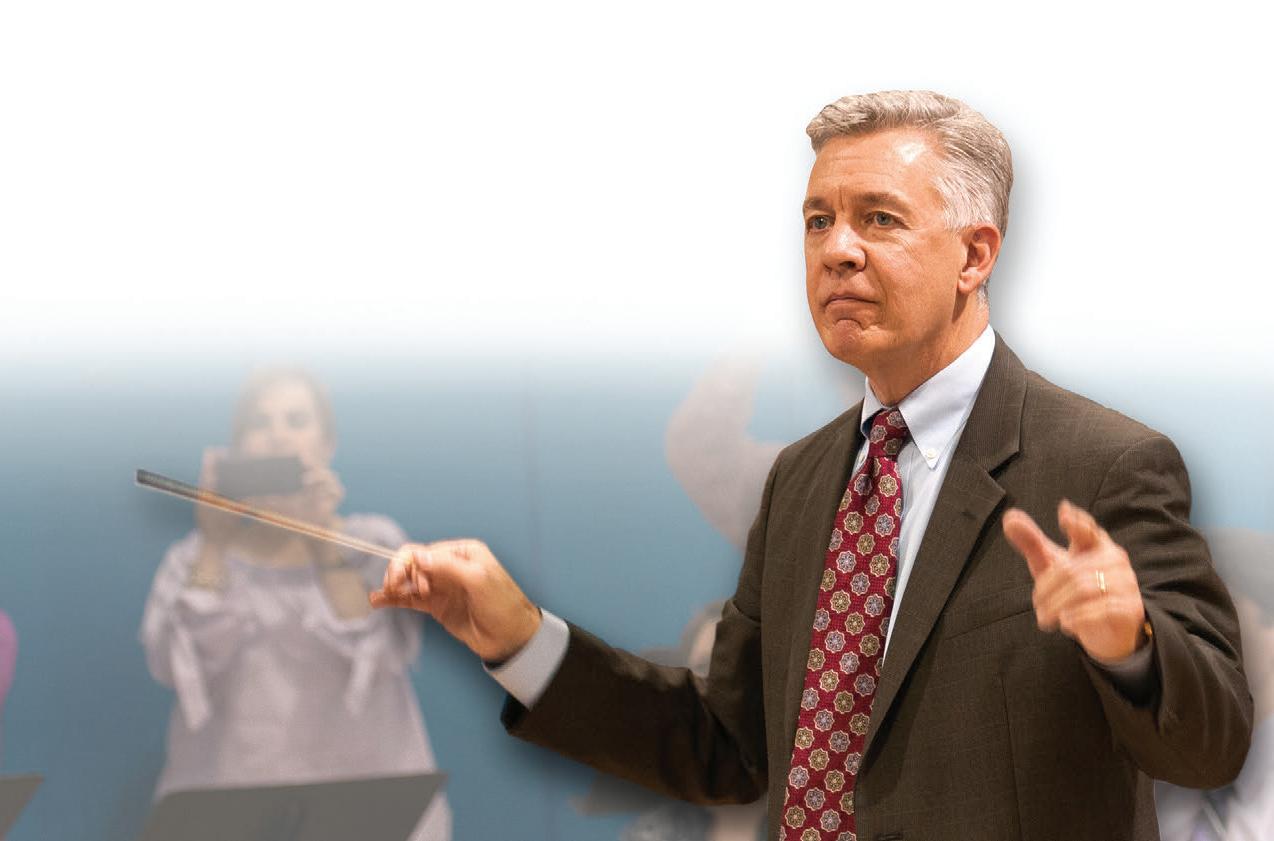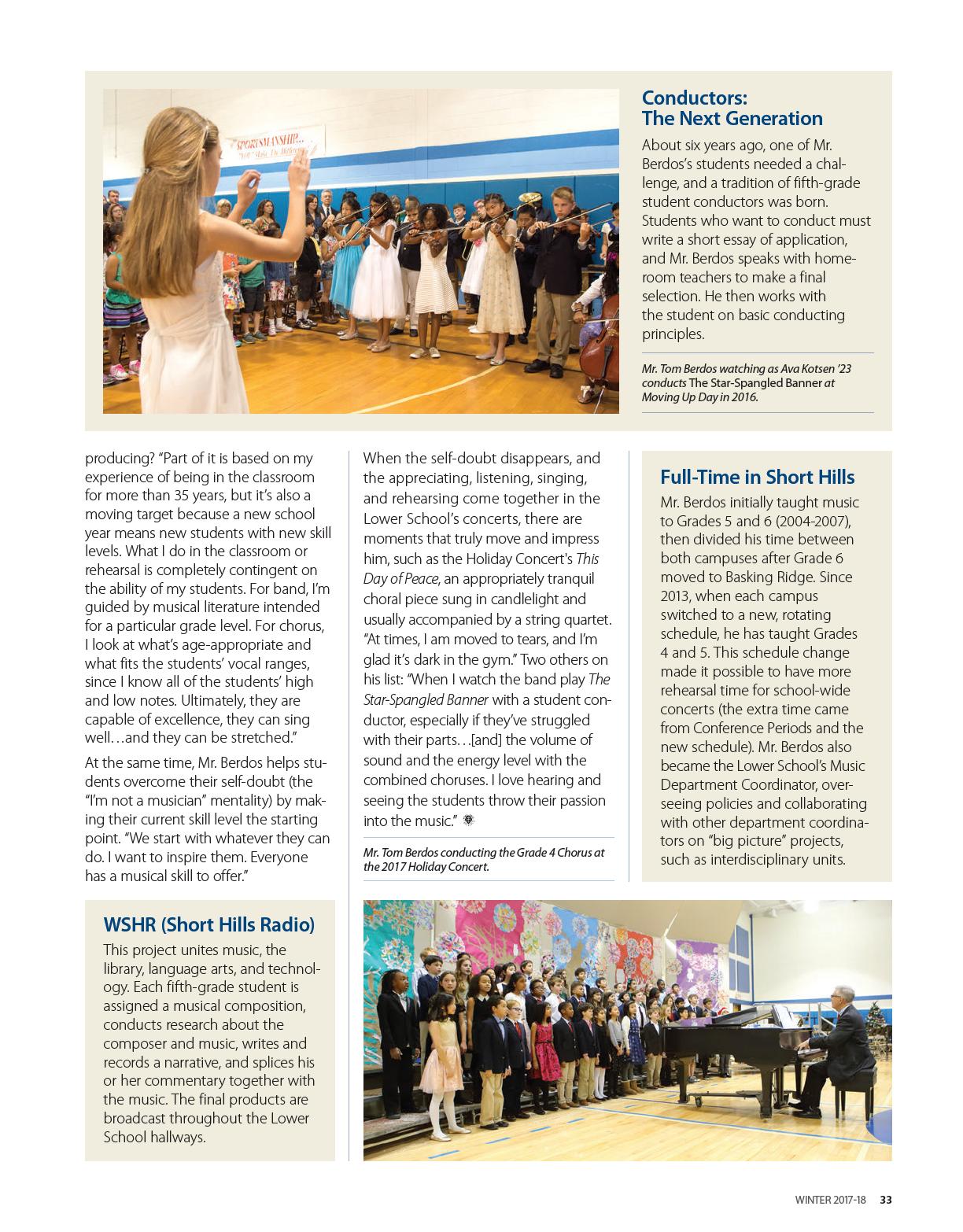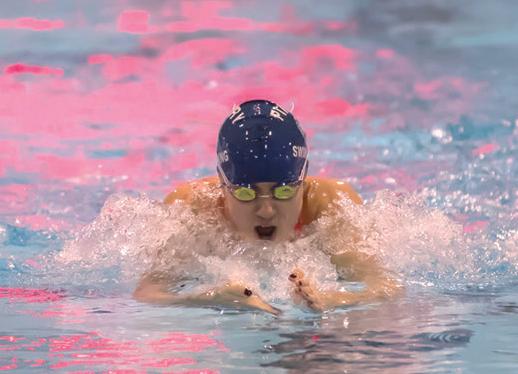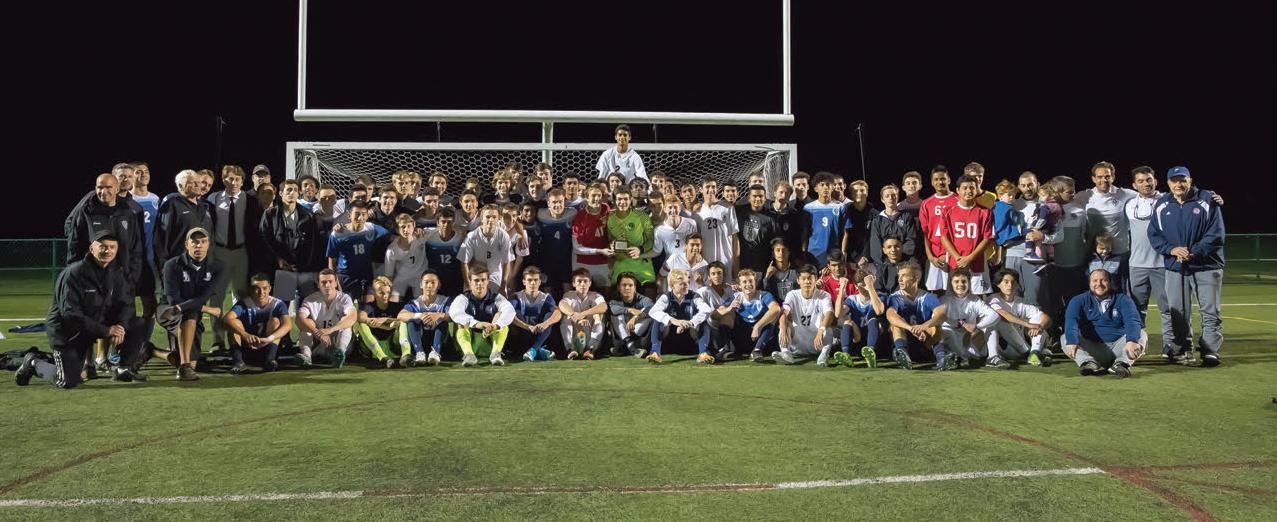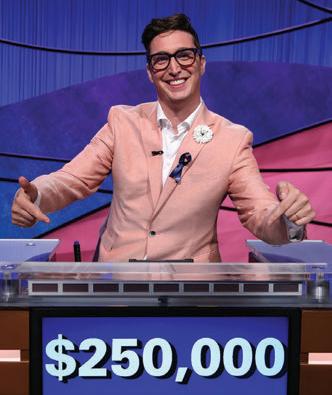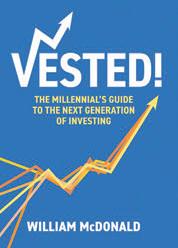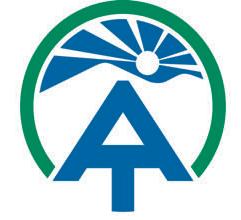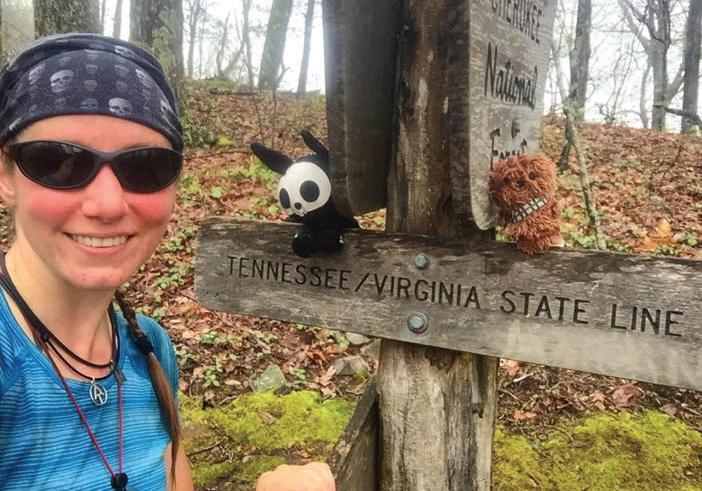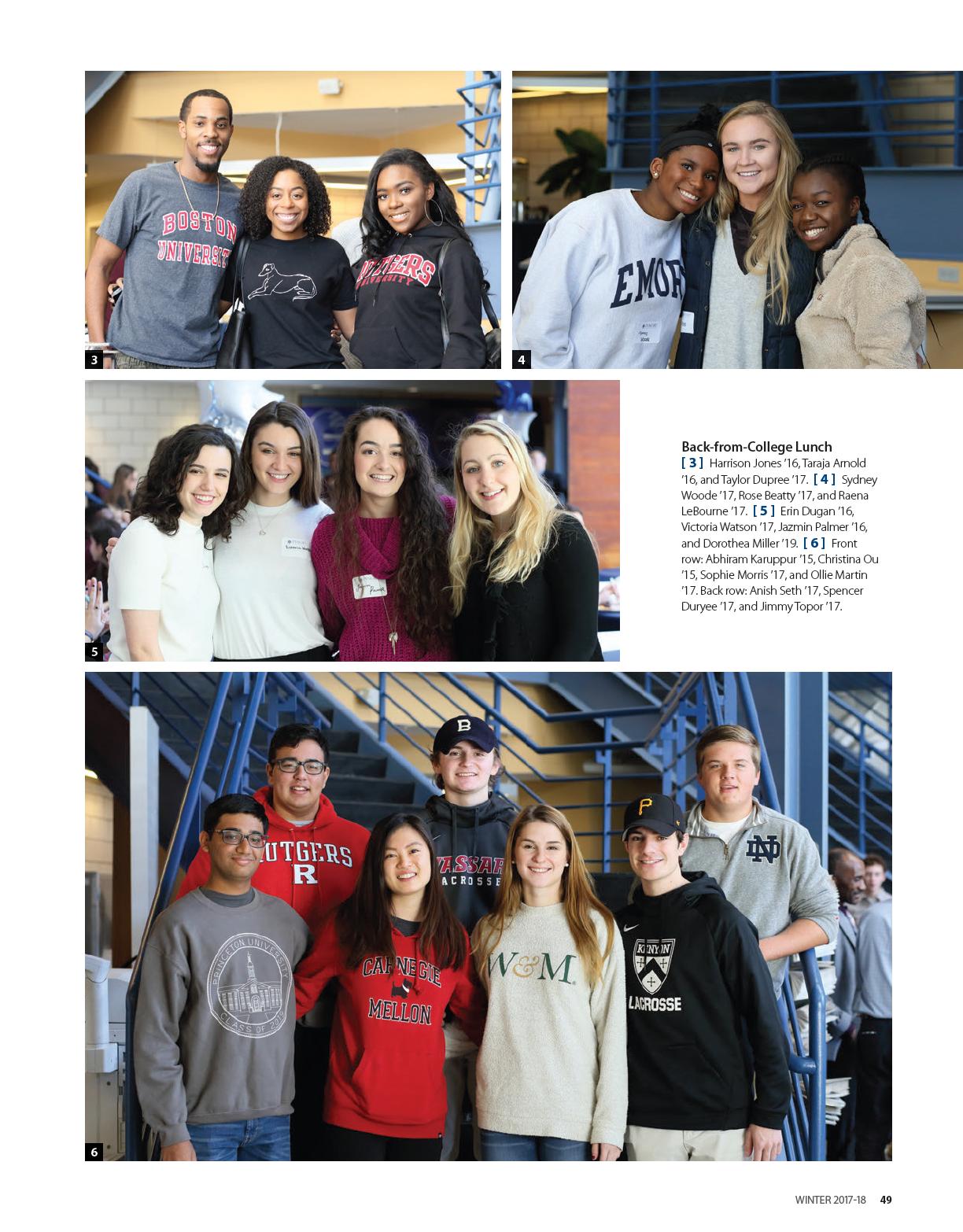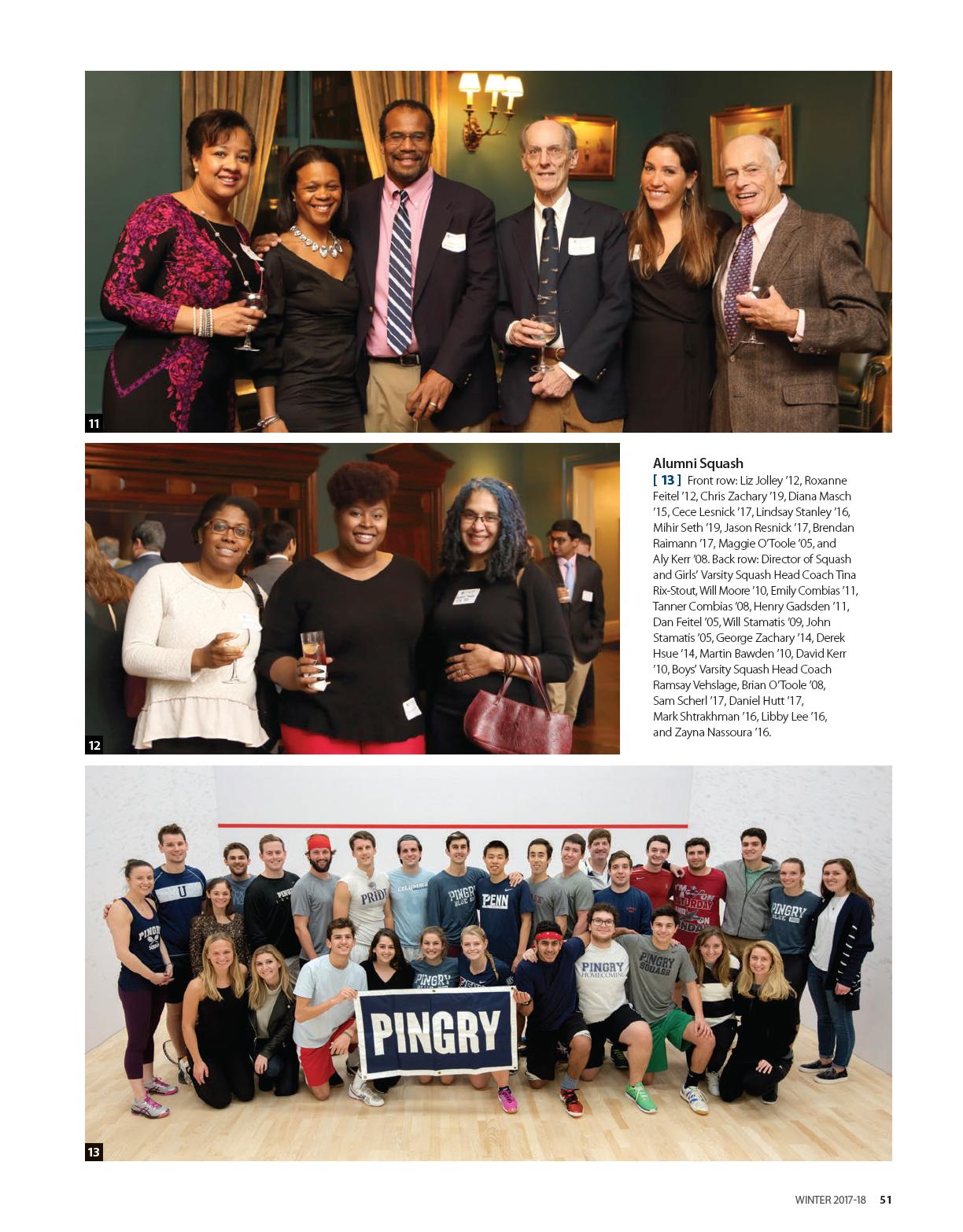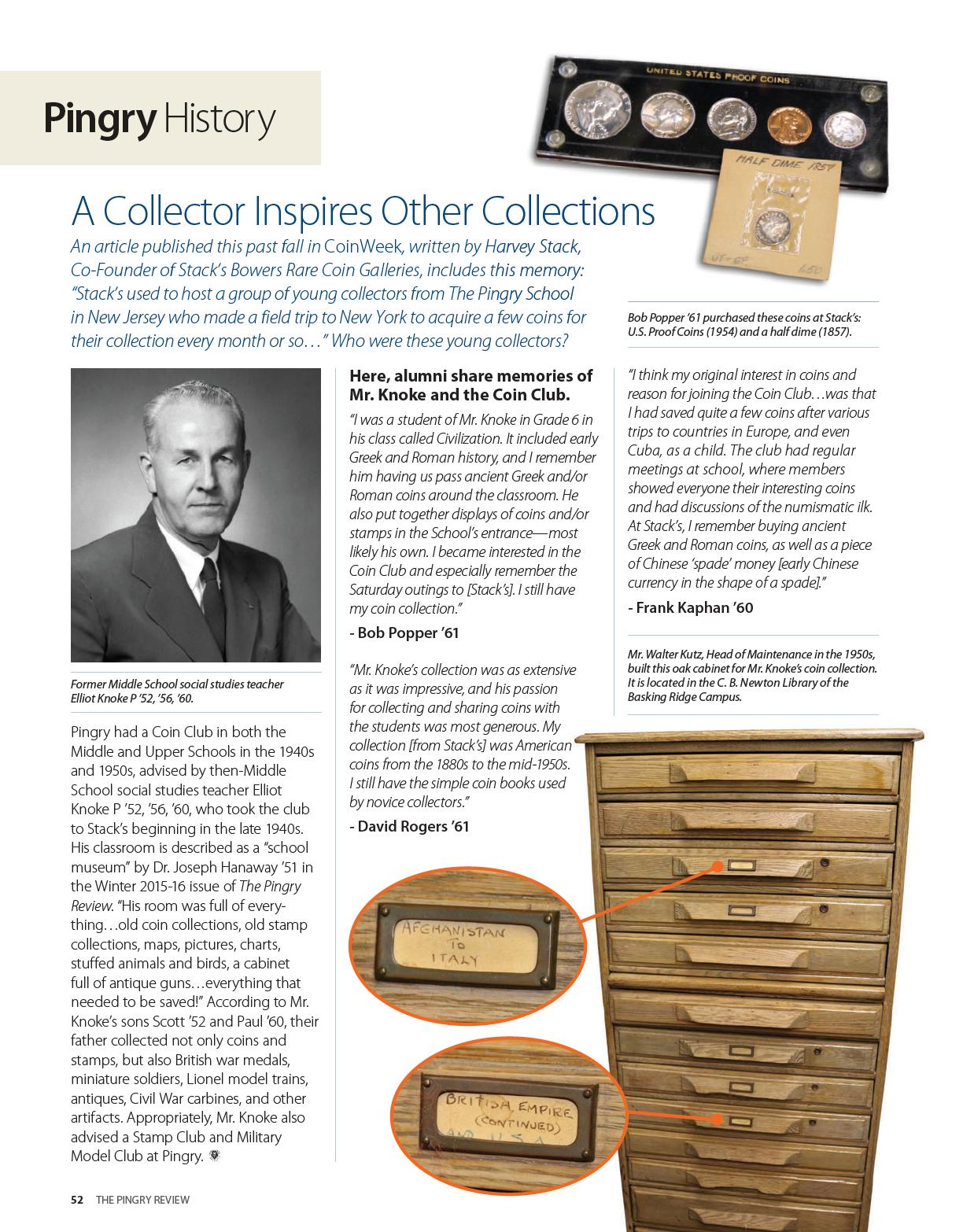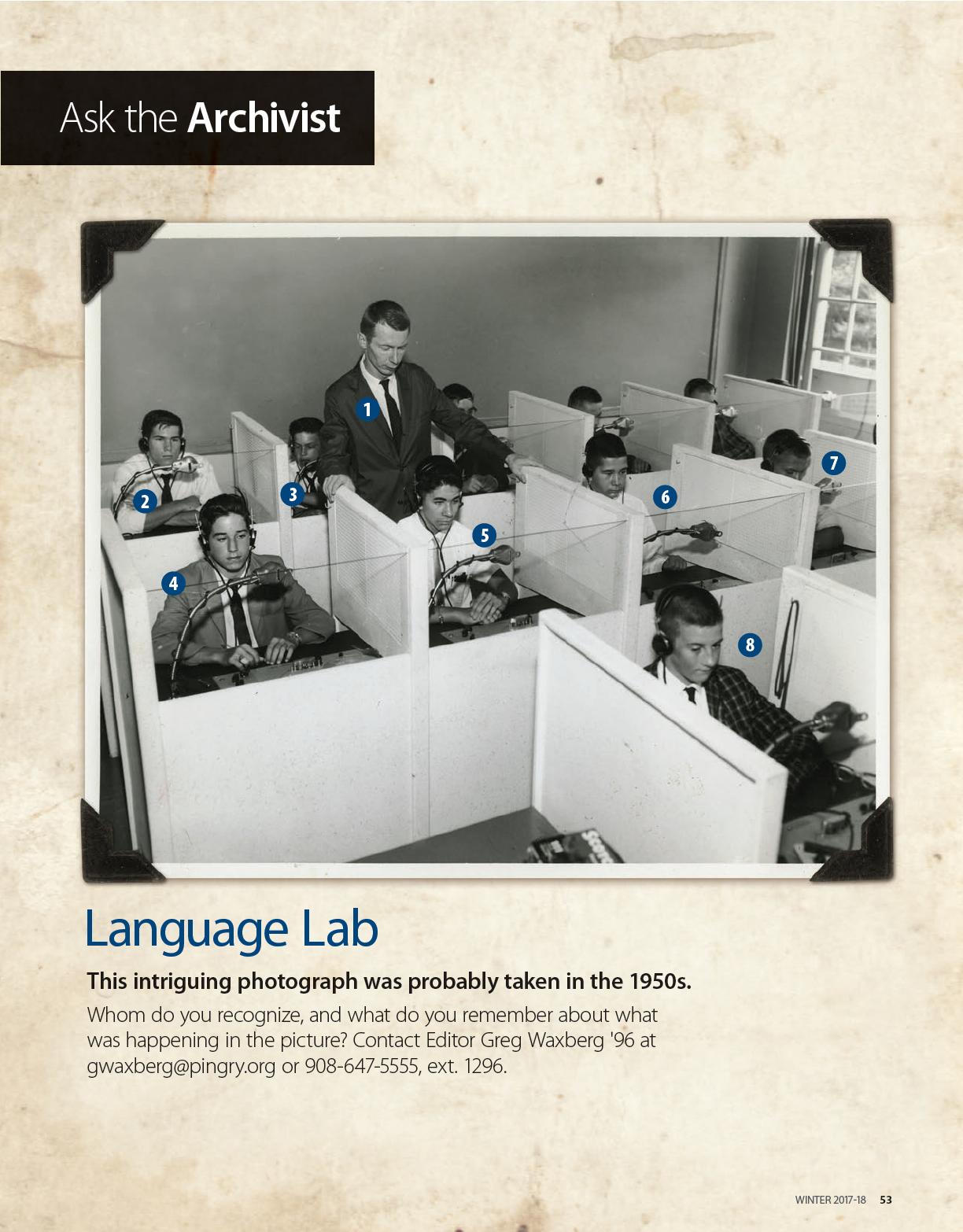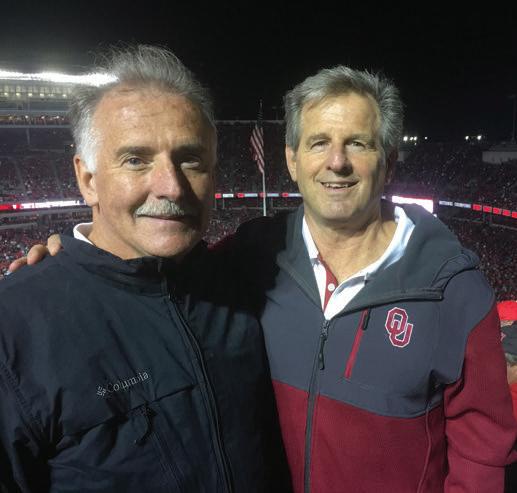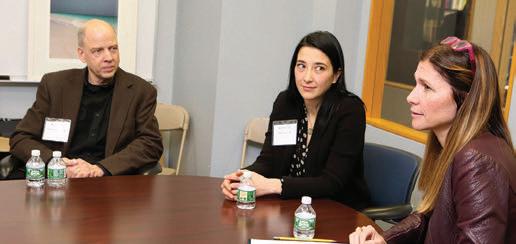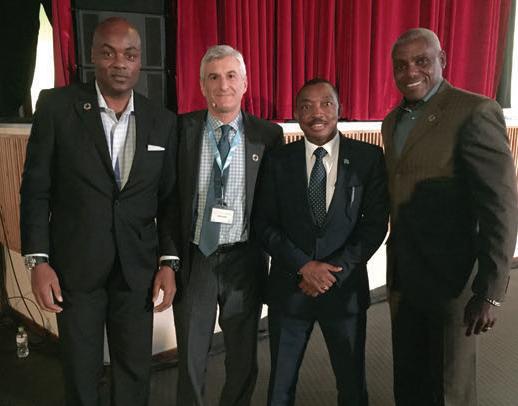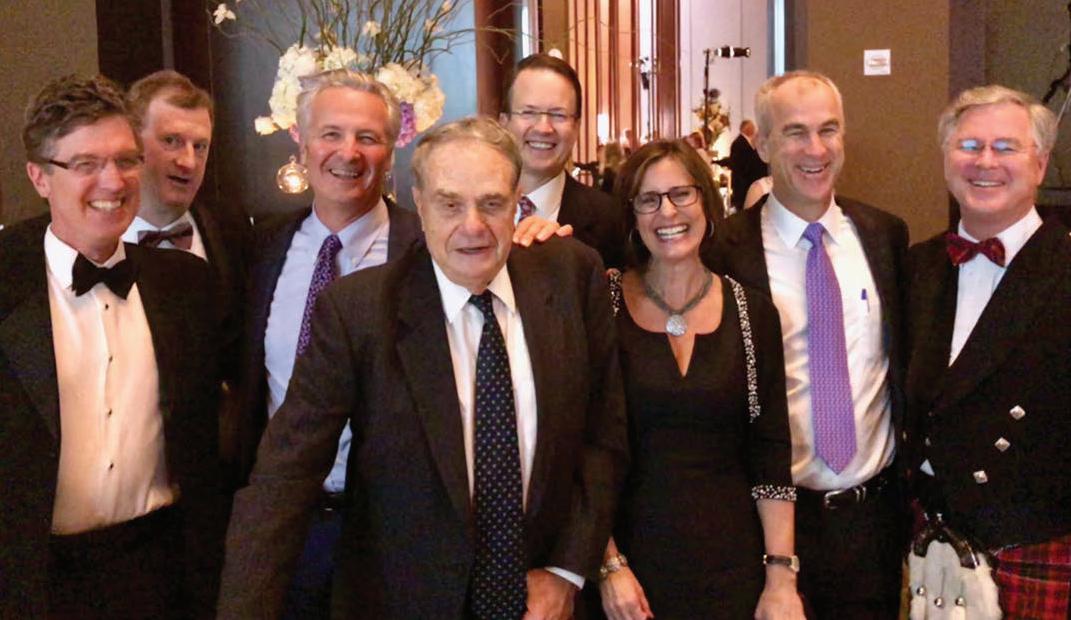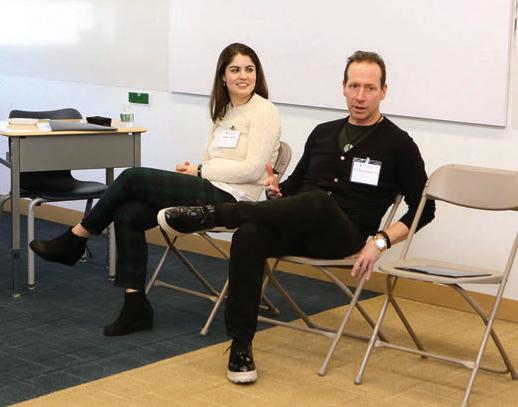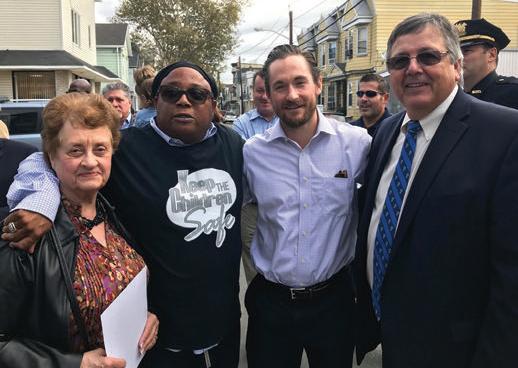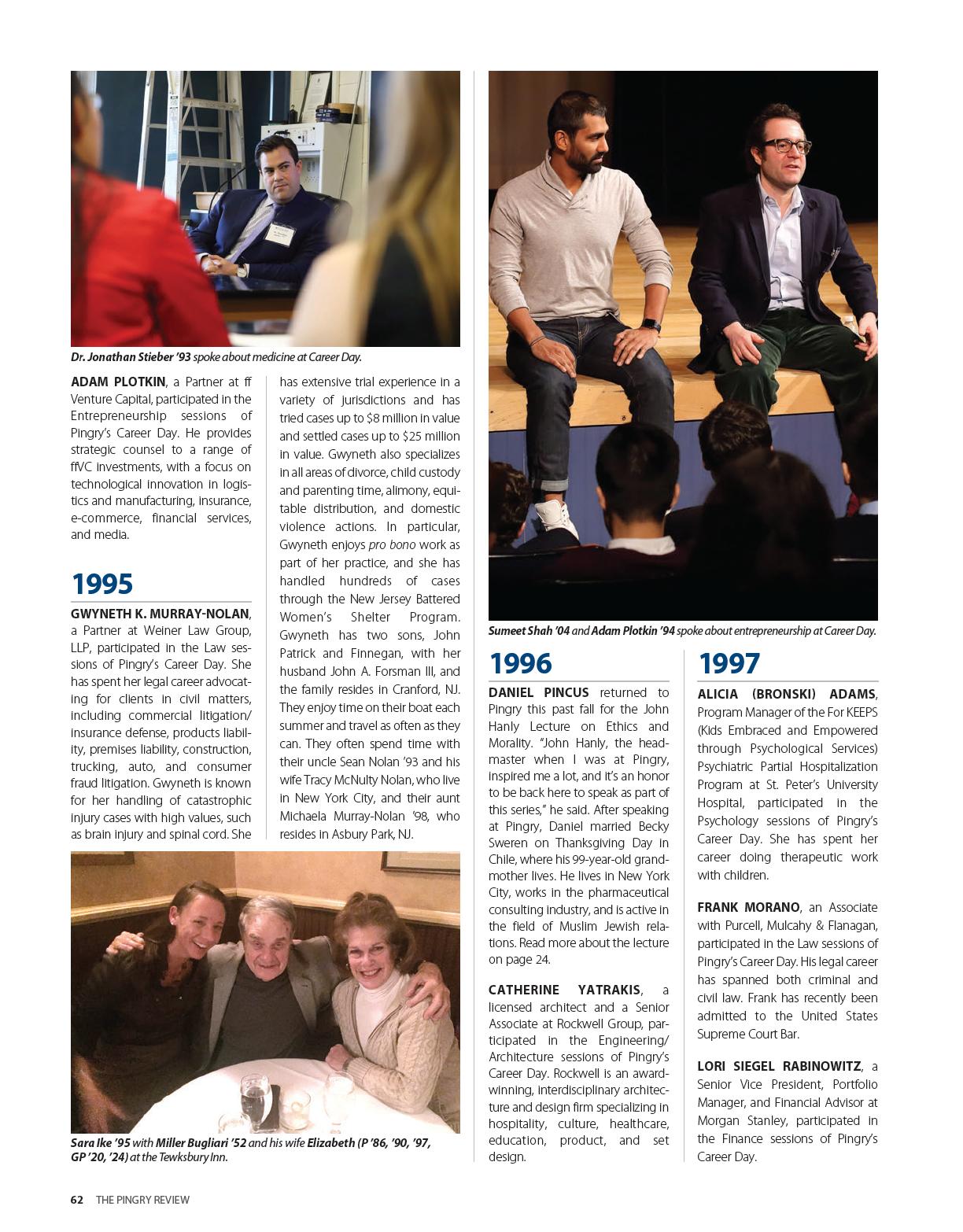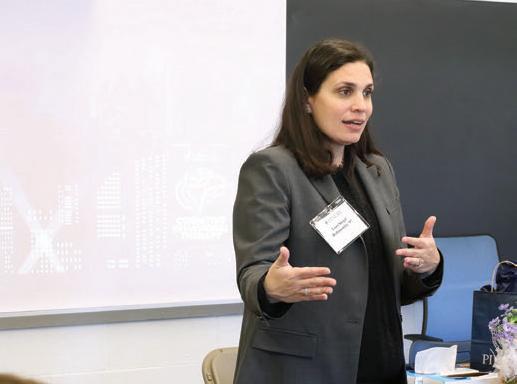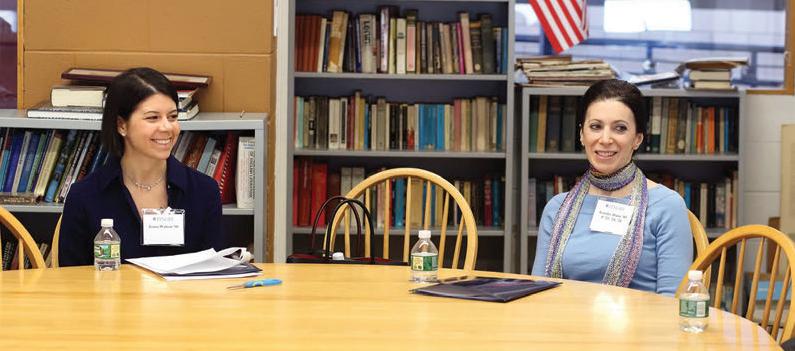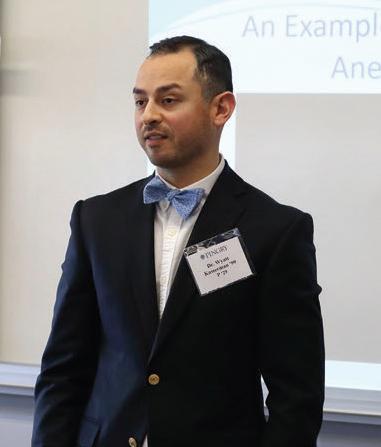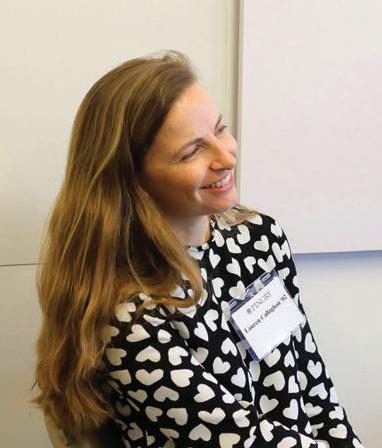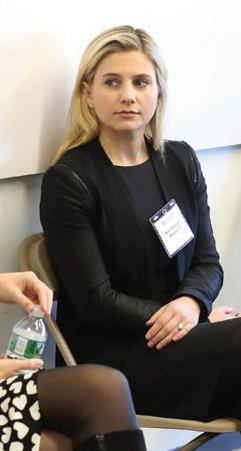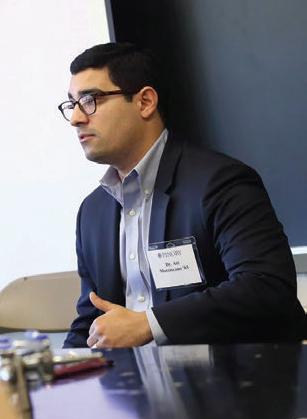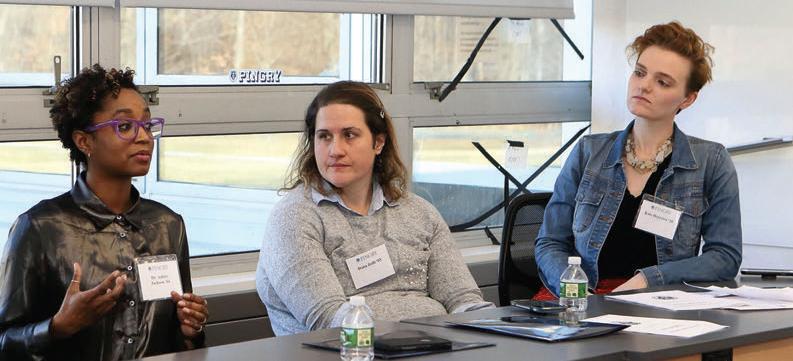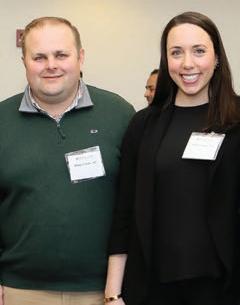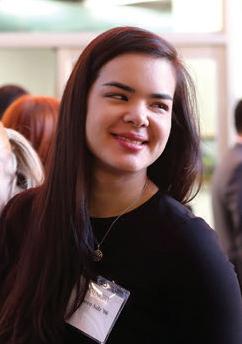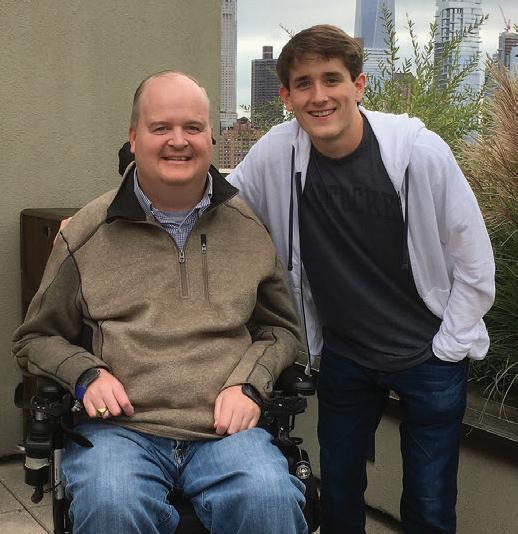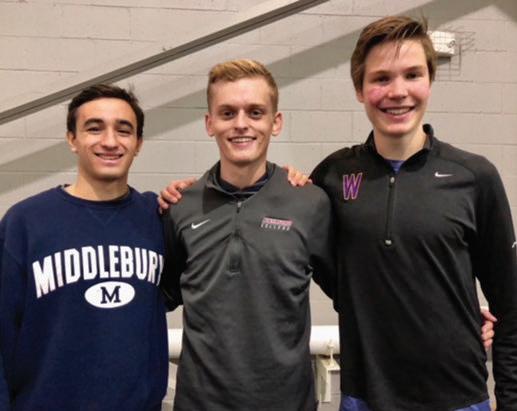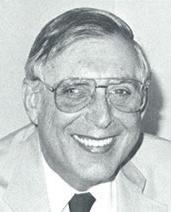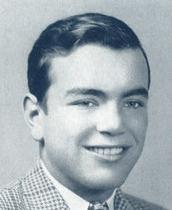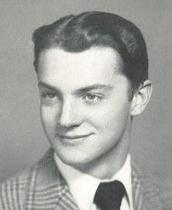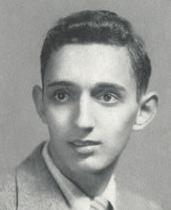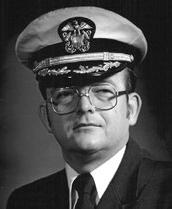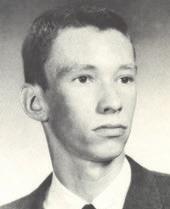Traversing the Trail
Beginning at different times and heading in opposite directions, Dr. Jamie Marsden ’02 and Dr. Robert King ’79, P ’07, ’12 recently hiked the entire Appalachian Trail, which extends from Mount Katahdin in north-central Maine to Springer Mountain in northern Georgia—at nearly 2,200 miles, it passes through 14 states*.
Dr. Marsden, hiking partway with her former college soccer teammate Carrie Yehle and then hiking alone, set off from Maine in June 2016 for what would be a seven-month hike (not including about two months off trail). Dr. King, hiking with his daughter Meredith, set off from Georgia in February 2017 for what would be a five-month hike. Along the way, both parties blogged, and, yes, their paths crossed, at Woods Hole Hostel in Pearisburg, VA. The Pingry Review asked them (separately) about their experiences.
Why did you want to hike the Appalachian Trail (AT)?
RK: It was my daughter’s idea. My wife Nancy is from Maine, where we have a vacation home on the coast. I’ve loved hiking since I was in high school, and I often took my kids and their friends
hiking and camping in northern Maine in Baxter State Park, where Mt. Katahdin, the northern terminus of the AT, is located. So, the idea intrigued us. Then, on Father’s Day [2014], my two daughters and I hiked Bear Mountain in New York. The AT goes over that [mountain], and we met a thru-hiker. Earlier that day, we had been discussing the possibility of my younger daughter taking a gap year between high school and college, which was about the same time I was considering retiring. When we saw the thru-hiker, the light bulb went on. My younger daughter [Meredith] said, excitedly, “That’s what I can do on my gap year—I’ll thru-hike the AT. And, Dad, you can come with me!” Of course, there is only one answer to that invite. What a great opportunity to share such a unique experience.


JM: I have hiked my entire life. I grew up with my dad sharing stories of his hiking adventures as well as his dream of hiking the entire AT. After he and I hiked Mount Washington in New Hampshire, part of the AT, when I was 7, [hiking the entire AT] became my dream, too.
What research did you do?
RK: The main areas of research were food, gear, and schedule. Even though I’d done a lot of hiking, backpacking, and camping, doing a five-month hike in a huge range of climates and weather would be a completely different and much more demanding experience. My wife and I read books written by thru-hikers and followed a blog called AppalachianTrials (since renamed The Trek). We researched gear online with various outdoor magazines and organizations. We did talk to a family friend who thru-hiked the southern half in 2016. Food was complicated because my daughter has allergies, so we prepared our own meals ahead of time—cooked them, dehydrated them, and vacuum-sealed them.
Dr. Jamie Marsden ’02 at the southern terminus in Georgia.
Dr. Robert King ’79, P ’07, ’12 and his daughter Meredith at the northern terminus in Maine.
JM: I read books such as A Walk in the Woods and Not Without Peril, and I was on social media, speaking with past thru-hikers and prospective thru-hikers. I chatted with lots of other hikers, in general, and I did test runs on sections of the trail.
How did you determine that you were physically capable of hiking it?
RK: My daughter (like all my kids) is a high-level, competitive swimmer, so we knew she was fit and would do fine. I work out regularly, so I was pretty sure I’d be fit enough. Six weeks before we started hiking, we began special prep by wearing our backpacks with added weight in them and doing Stairmasters and treadmill walks every day, increasing the weight and length of time. It still took us a few weeks on the trail to get our “trail legs”—the ability to hike 20-25plus miles a day on rugged terrain at a good pace.
JM: I did a lot of training in the gym, and I hiked with my full pack as often as I could. But, once on the trail, I learned that none of that mattered! I still was not in shape for the trail. The trail put me in shape! The only thing that really prepares you for the trail, is the trail. But general fitness is helpful, too.
Did you stay overnight in a town, stick to shelters on the trail, or do both?
RK: A combination. Most thru-hikers camp out for 3-5 nights, then go into town and stay at a hostel or hotel for a night, then get back on trail. We did the same thing, but, rather than staying at a hostel (generally), we rendezvoused with my wife who was following along in an RV to make our food re-supply feasible. On trail, we usually camped near shelters (three-sided lean-tos with roofs) located every five to 10 miles along the trail and near water sources. If the weather was bad, we’d sleep in the leanto in our sleeping bags. If the weather was okay, we’d sleep in hammocks with bug net coverings and rain tarps over them. We chose hammocks instead of tents for flexibility—we could throw them up between two trees anywhere.
JM: A combination. Typically, I would spend up to seven days in the woods/ mountains, then resupply in town. When in the woods/mountains, I either slept in my tent or in shelters, depending on the weather. When it rained, I tried to shelter because packing a wet tent is frustrating, and it’s difficult to get dry again. Once the temperatures started to drop, I would sleep in the shelter for more warmth.
Did you have a trail nickname?
RK: Mine was Doc because, when I took my daughter and some of her friends backpacking years ago, one of them (Alexa Buckley ’16) insisted on calling me “Dr. King” (I have a Ph.D. in Chemical Engineering). We felt that was way too formal, so I became Doc. My daughter got hers, Tunes, from another thru-hiker because she likes to sing Broadway show tunes, and did so on the trail.
JM: Dori, the misspelled version of Dory, the absent-minded fish from Finding Nemo. Originally, a college friend who met us on day one called me Short Term [as in “short-term memory”] because I couldn’t remember stories from our college days—I’ve had a lot of concussions from playing ice hockey and have difficulty remembering things. As Carrie and I made our way through Maine, northbounders wanted to know our trail names, but mine confused them because they thought it meant I was only on the trail for a short period of time! Well, one day, two northbounders decided Short Term was not good enough and thought Dory would be a much better fit. Then, I accidentally spelled it wrong. On the trail, I recognized faces, but forgot names, and couldn’t remember events that happened along the way. That’s why I wrote everything down, because I knew I would forget the details.
Were you ever concerned about staying hydrated?
RK: For the most part, we had a very wet year. According to my daughter’s records, it rained 44% of the days we were on trail, so we never had problems getting water. Only one time did we get dehydrated—in the south, when the temperature suddenly sky-rocketed from the 50s to the 90s, and we didn’t ramp up our water intake fast enough to keep up with our sweating. But we learned our lessons and never had another problem.
JM: Water was a big problem. I started in June 2016, the year when the drought hit the East Coast hard and when the Gatlinburg [TN] fires happened. When I reached Massachusetts, the drought extended all the way down to Virginia. As I continued, it went all the way down to Georgia. There were several times
Dr. Robert King ’79, P ’07, ’12 and his daughter Meredith on McAfee Knob in Virginia.
I had to depend on “trail angels”—people who help hikers out of the kindness of their hearts—for jugs of water that were left at the road crossings for the hikers. I also depended on an app called Guthooks with information on the shelters, towns, and water sources. What was really nice was that anyone who used this app could leave a comment on the water sources, with a date. This gave me up-to-date information regarding which water sources were still running.
What were your most memorable moments?
RK: Ah, so many: reaching the end; a few times when friends surprised us on the trail and brought us “trail magic”— food, drink, and encouragement; enjoying some beautiful vistas or sunsets at the tops of mountains or along ridges; a 13-hour, 27-mile hike through a blizzard to get to a hostel in Erwin, TN; doing 57 miles in the two days at the end of the 100-mile wilderness before we summited Katahdin at the end; spending 1.5 hours going through the Mahoosuc
Notch boulder field—up, around, under, through the giant-sized obstacle course; being totally soaked (including boots filled with water) during two days straight of drenching rain in the Shenandoahs; and so many others.
JM: Three come to mind. When I made it to the top of Katahdin and started my
thru-hike as a southbounder, I had tears in my eyes. This was a life dream I was completing for both myself and my father. When I crossed the bridge into Harpers Ferry, WV, the psychological halfway point of the AT [the halfway point did not have a marker, but Harpers Ferry was the closest town to it], I had tears in my eyes again, barely believing I had made it that far. When I crossed the proverbial finish line and reached the plaque on Springer Mountain, I walked through a crowd of people and collapsed on my knees in a bawling fit of tears. Once everyone around me figured out what had happened, they cheered and celebrated with me. But I felt like I was mourning the loss of a good friend by leaving the trail.
Hikers on the AT vary their meals. Which meal was the most memorable?
RK: Perhaps the most special on-trail meal was a surprise. A “trail angel,” who calls himself Carl the Omelet Guy, set up a whole kitchen in the middle of the forest approaching the White Mountains and would make omelets for thru-hikers who passed by—however many eggs you wanted, with cheese, ham, onions, and peppers. It was incredible! I had a three-egg omelet, and my daughter had two of them.
JM: My favorite dinner was what I called a taco dinner. It was dehydrated ground
beef, couscous, cheese powder, taco seasoning, and crushed chili cheese Fritos. It was amazing. Otherwise, every time I made it to town, just like all the other thru-hikers, I ate as much as possible.
Did the AT give you a new appreciation for nature?
RK: We’ve done enough wilderness backpacking to already appreciate nature, and there are much easier ways to appreciate nature without the suffering of the hike. Though there clearly were nature highlights, overall it was much more about developing personal character and resilience.
JM: I grew up hiking in the White Mountains of New Hampshire, so I always had an appreciation for nature. But the AT made me much more aware of what we take for granted in civilization. I try to walk more frequently, drive less, and, when I am walking, I pick up trash, because I did that on trail.
What was your approach to communications, in terms of the value/detraction during your hike? Did you ever intentionally limit your connectivity?
RK: We had two sources of connection, cell phones and GPS tracker. With our cell phones, we had surprisingly good connectivity throughout most of the hike, but, to save battery power, we kept our phones off during the day unless there was an emergency. At night, we’d write our daily blog entries. Another key element of connectivity was our connection to real life. Unlike most thru-hikers who, off trail, stay in a hostel with other thru-hikers, since we met up with Nancy frequently, and some of our family and friends would periodically also meet us, we stayed pretty connected to our real life.
JM: I actually limit my connectivity in daily life, but I found myself more connected when on the trail. I was accepted as a blogger with the website thetrek.co and felt obligated to post frequently. I started to have avid readers/
Dr. Robert King ’79, P ’07, ’12 and Dr. Jamie Marsden ’02 at Woods Hole Hostel in Pearisburg, VA. They discovered their Pingry connection during introductions at a family-style dinner.
followers and did my best to keep them up-to-date. I took thousands of pictures and posted those on Instagram as well. I called my family and my significant other as frequently as I could. The blog made me feel as though I were too connected at times, so I did my best to juggle this with trail life.
What was the most difficult part to hike, and why?
RK: I have three answers. First, Pennsylvania…extremely rocky with no redeeming qualities—no mountain peaks with magnificent views, no interesting topography as a reward for the pain inflicted on your feet. Second, the Unaka and Roan Mountains in Tennessee, because we hit a blizzard and freezing temperatures, so we were hiking in snow 18” deep (with drifts double that) and wind chills below zero. Third, northern New England, because it is the most rugged part of the AT—elevation changes, and the rockiest, rootiest trail the whole way through—and because we got Lyme disease there, at different times, which made us very tired, achy, and, psychologically, very pessimistic and ornery.
JM: Maine! The terrain is very difficult! The elevation gains/losses are enormous, the trail is very rocky and rooty, and, as a southbounder, you start with
some of the toughest parts of the entire AT. What is considered either the “most hated” or “most fun” section of the trail, Mahoosuc Notch, is in southern Maine —this was my favorite section! It is one mile and takes anywhere from 1.5 to 4 hours to navigate. It is a giant, challenging, fun boulder field.
How did living in the wilderness for several months influence your thoughts on civilization?
RK: Two thoughts. One, the U.S. is a big country with lots of diverse socioeconomic cultures. We—the broader Pingry community—live in an elitist bubble of highly-educated professional families who look at the world one way and hold values commensurate with that. Along the trail and in all the small, rural towns that we encountered, there were people from different backgrounds, holding different perspectives on life and politics. Two, civilization is a very good thing. I love the wilderness, but, when you’re living in it, you’re spending all your time figuring out how to survive with minimal discomfort. Are there times of peace and relaxation, enjoying the grandeur and beauty of creation? Sure. But they seem all too brief and overshadowed by the all-consuming thoughts of water, food, your strength, the weather, encountering animals, and so on. Civilized infrastructure enables us to not worry about basic survival issues.
JM: I think I live in some sort of “fake world,” and the “real world” is still waiting for me in the woods. When I came back to society, I was hit badly by something called “post-trail depression,” and it took me three months to recover. I couldn’t even watch TV because I was getting bombarded with “buy this” or “you need this” when I had everything I needed on my back for months! I have found that I am much more conscious about recycling and packaging. We package things way too much and create a lot of unnecessary waste. I try to do my part by recycling everything and by picking up other people’s trash when I am out walking. In the near future, I hope to make my home more nature-friendly, meaning more dependent on solar power, wind power, and even water power. I would like to start making some of my own food and depending less on corporate society. I’ve become less materialistic and more self-sufficient, and I challenge our society to do the same!
For people who are considering hiking the AT, what advice do you offer?
RK: Don’t do it if your main goal is to commune with nature or have time alone with yourself to think. You won’t. Know why you’re doing it, and remind yourself of that often, because you’ll be tempted to quit many times, and there’ll be ample opportunity.
JM: Hike your own hike! Don’t worry about how fast you go, or what other hikers are doing or aren’t doing. Focus on what you are doing. When the hiking gets rough, the only thing that will keep you from giving up is you. Go out there with purpose, and stick to it. And be prepared to return to society. Have some kind of support that will help you get through the shock of returning to the “real world.”
Jamie Marsden’s blog: thetrek.co/author/jamie-marsden
Robert King’s blog: meredithandrobbyhiketheat.wordpress.com
* The Appalachian Trail passes through 14 states: Maine, New Hampshire, Vermont, Massachusetts, Connecticut, New York, New Jersey, Pennsylvania, Maryland, West Virginia, Virginia, Tennessee, North Carolina, and Georgia.
Dr. Jamie Marsden ’02 at the Tennessee/Virginia state line.
School building and Hostetter Arts Center. The entire campus operates more efficiently as a cohesive system.
Four years later, a 394-kilowatt solar panel array became operational on the Upper School building’s roof, producing about 20 percent of the building’s electricity. Pingry benefits financially from the panels in three ways: a smaller burden on the campus’s power grid during school hours (lower costs from less electricity and a steady pattern of usage); the panels occasionally produce more
power than needed, so Pingry receives a credit for the excess; and the School benefits from tax incentives, thanks to a 10-year SREC (Solar Renewable Energy Certificate) contract with JCP&L.
How does a non-profit organization benefit from tax incentives? Chief Financial Officer and Director of Operations Olaf Weckesser P ’25 explains. “The State of New Jersey offers incentives for installing renewable energy systems, so we are entitled to a tax credit per unit of solar power. As a non-profit institution, Pingry doesn’t pay taxes, so we can’t take advantage of the tax credit directly. Instead, we entered into a lease transaction with a financial institution—technically, the bank owns the panels and benefits from the tax credits, while Pingry was able to obtain the panels for a lower cost than we otherwise could have. Pingry then also receives payments from the state based on the amount of solar power produced.”
In October 2012, less than one year after activating the solar panels, Pingry unveiled the energy-efficient, LEED Goldcertified Beinecke House (headmaster’s residence), proudly and painstakingly designed to be one of the greenest homes in New Jersey. Among its numerous features, the home boasts solar electricity, a solar thermal hot water system, energy-efficient windows, dimmable LED lighting, Warmboard radiant heating in the floors, and exterior walls constructed with 18- to 24-inch thick Durisol Blocks (a cost-effective, sustainable alternative to more ubiquitous materials such as brick, block, and timber-frame).
Most recently, energy efficiency at Pingry took center stage with the Miller A. Bugliari ’52 Athletics Center (BAC), which opened in January 2017, featuring the most current technologies. Mr. Weckesser points out that “the entire building is heated by two boilers the size of filing cabinets, and the Newhouse Family Sports Arena is ventilated by the same sophisticated air rotation system used by the New York Giants in their indoor practice facility.”
Kevin Aitken, Senior Sports Architect at CHA Consulting, Inc., the engineering firm responsible for the excellent work on the BAC, reveals other intricacies: exterior walls and roof insulation composed of high R-value materials (insulating materials that resist heat flow—the higher the R-value, the higher the insulating power); tinted glass to reduce solar heat gain; and argon gas-filled windows (gas between panes of glass offers better insulation, which increases energy efficiency). Other energy-efficient features include water fountains designed to fill reusable water bottles (while displaying a running count of how many plastic bottles have been saved) and low-flow shower heads in the changing rooms. The BAC is even designed to accommodate solar panels, a decision the School will make based on energy market economics.
On a smaller scale, Pingry’s energysaving initiatives include LED lighting; energy-efficient condensing boilers; a Building Management System that monitors hot water and heating; and wireless lighting with occupancy and daylight sensors. The School also participates voluntarily in the New Jersey PLC (Peak Load Contribution) energy curtailment program; when high demand is expected, large power users such as Pingry are notified to conserve electricity by turning off non-critical systems, in exchange for credits for each watt saved. Over the last two summers, Pingry has reduced demand by over 300 kilowatts, resulting in savings of about $21,000.
And, leaving no stone unturned, Pingry’s operational efficiency efforts include two charging stations for electric vehicles that were added to the Basking Ridge Campus in 2017. “Electric vehicles are more operationally efficient than internal combustion engines,” says David M. Fahey ’99, Assistant Director of Operations & Strategic Initiatives. On average, charging an electric vehicle costs one-half to one-third the price of filling a car with gasoline. “We’d love to eventually replace all Pingry vehicles with electric vehicles. We could have fleets of electric vehicles that we’re able to charge on campus,” Mr. Fahey says. A visionary, energizing thought, indeed!
Solar panels on the Upper School building’s roof. Also visible is The Carol and Park B. Smith '50 Middle School (right), whose energy systems are integrated with the Upper School building.
1974
GLENN MURPHY writes, “In November, I wrapped up a week in Fort Myers, FL, playing baseball for the Livingston, NJ Dodgers in the Classics Division (60+) of the Roy Hobbs World Series. There were 44 teams from around the country.” How did he become a player for the Dodgers? “I was looking to make a comeback, at least for a week, now that I’ve passed 60 years old, so I did an Internet search and found the Roy Hobbs World Series in Fort Myers, where they host a tournament for teams of older players from throughout the country every November at minor league stadiums. In a video I found on their website (RoyHobbs.com), they interviewed the coach of a team from New Jersey that plays each year in the tournament, so I reached


out to him and was invited to practice with them and eventually to play in the tournament with them.” How did they do? “We finished with a record of four wins and two losses. I pitched and played the outfield just as I did 43 years ago for Pingry, though I’ve lost a bit off the fastball, and the curve doesn’t have quite as much bite (LOL). Any fellow teammates interested in joining me next November?”
1979
ANNE DELANEY P ’09, ’11, ’14, ’14 was profiled in several New Jersey newspapers, including The Bernardsville News, in late October for her efforts to assist those who are struggling with mental illnesses. She volunteers with Collaborative Support Programs of New Jersey (CSPNJ), a non-profit agency that provides mental health assistance across the state. The organization honored her on November 1 at their tribute luncheon. In the article, Executive Director Jody Silver said, “Anne’s a mover and shaker … really hands on. She comes in and bonds with the people.” For two decades, Anne had a private practice, DeLaney Psychotherapy, working as a licensed clinical social worker specializing in grief and trauma; she retired in 2014 when her husband Chip Carver’s job took them overseas. Anne has also served on the Columbia University Global Mental Health Program for the past five years.
DR. ROB KING P ’07, ’12 finished hiking the Appalachian Trail with his daughter Meredith. Read more on page 42.
Dr. Ian Alexander ’72 and Dr. Steve Naughton ’72 at the exciting Ohio StateOklahoma football game in September.
Glenn Murphy ’74, No. 3 with the Livingston Dodgers, at the far right of the front row.
Dinner at Morris County Golf Club. Front row: Philip Haselton ’77, P ’12, Miller Bugliari ’52, P ’86, ’90, ’97, GP ’20, ’24, Frank DeLaney ’77, P ’12, and Jonathan Shelby ’74, P ’08, ’11, ’19. Back row: Peter Hiscano ’75, Jim Hoitsma ’75, Skot Koenig ’77, Chuck Allan ’77, Bruce Morrison ’64, Guy Cipriano ’74, P ’06, ’08, Tom Trynin ’79, Conor Mullett ’84, P ’14, ’15, and Dr. John Boozan ’75
1980
GAEL AMABILE married her longtime partner Dr. Paul Ziemer on September 9 at Westminster Presbyterian Church in Minneapolis.
DWIGHT HISCANO, an internationally-published and highlycollected photographer, and owner of Dwight Hiscano Photography, participated in the Visual Arts sessions of Pingry’s Career Day. He has been photographing the American landscape for over 30 years.
1981
DR. MATTHEW CHOW P ’13, ’16, an anesthesiologist with Anesthesia Associates of Morristown and Head of Regional Anesthesia at Morristown Medical Center, participated in the Medicine sessions of Pingry’s Career Day.
1982
JONATHAN KARP, President and Publisher of Simon & Schuster, participated in the Media/ Communications sessions of Pingry’s Career Day.
Miller Bugliari ’52, P ’86, ’90, ’97, GP ’20, ’24, Chris Bartlett II ’79, and Leighton Welch ’79
Dwight Hiscano ’80, MJ Tyson ’04, and Meg Lucas Sellig ’88 spoke about visual arts at Career Day.
The 6th annual Class of 1979 holiday cocktail party at Huntley Tavern. Pictured are Tom Trynin ’79, Genesia Perlmutter Kamen ’79, P ’11, ’13, Mark Bigos ’79, P ’22, Dan K. ’79, Steve Lipper ’79, P ’09, ’12, ’14, and Jon Younghans ’79, P ’20
Ray Amabile (attended SHCDS and Pingry before transferring to Hun), Gael Amabile ’80, Dr. Paul Ziemer, and Jean Amabile Telljohann ’77.
Dr. Matthew Chow ’81, P ’13, ’16 spoke about medicine at Career Day.
Jonathan Karp ’82 and Karen Giangreco ’03 spoke about media and communications at Career Day.
ALISON LITTLE P ’22, a Principal in the Management Consulting group of KPMG, participated in the Management Consulting sessions of Pingry’s Career Day. She leads Solutions and Innovation for the Healthcare & Life Sciences industry group for KPMG’s Advisory services, and is the lead relationship partner for two major life sciences companies.
LANCE GOULD writes, “My new venture is a media-strategy firm called Silicon Valley Story Lab. We are working primarily with purpose-driven organizations, many tied to the United Nations and the Sustainable Development Goals. I have three partners, one in the Valley, the other two in Puerto Rico. And I will be based in Brooklyn. Work in the last few months has led me to Denmark, Sweden, and Botswana, and 2018 promises more work in Europe, Singapore, and Latin America.”
HENRY G. STIFEL III, Vice Chair of the Christopher & Dana Reeve Foundation’s Board of Directors, received the Foundation’s Arnold H. Snider Visionary Leadership Award at its annual gala benefit, “A Magical Evening,” at the Conrad Hotel in New York on November 16. In a press release, the Foundation’s President and CEO Peter Wilderotter said, “When we think about the Stifel family, we acknowledge them as the pioneers that ignited this enterprise over two decades ago. They were driven by family, friendship,
community, and a shared vision that they could improve quality of life for all individuals living with a spinal cord injury. Henry has been a beacon of light to the Foundation over the years.” At the gala, fellow Vice Chair John McConnell introduced Henry by saying, “If I’ve learned anything in the almost 12 years since I’ve known Henry, you never tell a Stifel that something can’t be done!” In his remarks, Henry said, “I’m proud to be
associated with the Christopher & Dana Reeve Foundation because, every day, this organization is allowing people with disabilities to have endless dreams and convert them to reality. I accept this recognition on behalf of all of you. Decades of support is allowing dreams to become reality. Thank you for choosing to stick with us for so many years. We have great things coming, and I so look forward to celebrating again with all of you.”
Alison Little ’82, P ’22 spoke about management consulting at Career Day.
Lance Gould ’83 moderating a panel on youth and entrepreneurship at the University of Botswana, with Olympic Gold medalist Carl Lewis (far right).
John Holman III ’79, P ’09, ’11, ’14, Scott Horton, John Apruzzese ’76, P ’06, ’08, Miller Bugliari ’52, P ’86 ’90, ’97, GP ’20, ’24, Dr. John P. Bent III ’80, Dr. Laura Kaltenbacher Ross ’82, Dr. Rob Macrae ’82, and Doug Macrae ’77 at the Christopher & Dana Reeve Foundation’s annual gala benefit. The event honored Henry G. Stifel III ’83, Vice Chair of the Foundation’s Board of Directors.
The University of South Carolina established the Ann Johnson Institute for Science, Technology & Society, named for the late DR. ANN JOHNSON ’83, who passed away in December 2016 at age 51. She served as an Associate Professor at the university, with joint appointments in history and philosophy. This institute will continue her legacy of scholarly research and interdisciplinary teaching and learning in science, technology, history, and society—most appropriate, because Ann worked in areas ranging from 19th century American history to 21st century nanotechnology, and was wellknown for bridging gaps among various disciplines. Her family founded the institute, which was established on July 1 and officially launched this past fall with hands-on activities, including an open lab session on forensic anthropology and a geology field trip.

McLaughlin family’s holiday luncheon for Miller Bugliari ’52 at Chick and Nello’s Homestead Inn in Trenton. Pictured are Edie (McLaughlin) Nussbaumer ’84, P ’18, ’21, Mike Coughlin ’90, Miller Bugliari ’52, P ’86, ’90, ’97, GP ’20, ’24, Lou Ruprecht ’56, P ’79, ’82, ’87, Mike McLaughlin ’80, P ’12, ’15, John McLaughlin ’78, Dr. Richard Schonberg P ’05, ’08, Dr. Mark McLaughlin ’83, and former Grade 4 teacher Mary Jean McLaughlin P ’78, ’80, ’83, ’84, GP ’12, ’15, ’18, ’21. When the family hosts the luncheon for Miller, they invite mystery guests.
1984
DR. MICHAEL NITABACH, a Professor of Cellular and Molecular Physiology and of Genetics at the Yale University School of Medicine, participated in the Science sessions of Pingry’s Career Day. He enjoyed seeing his classmates Edie (McLaughlin) Nussbaumer, Betsy (Lucas) Vreeland, and Martha (Ryan) Graff on campus, and speaking with Headmaster Conard, Mr. Lav, Mr. Bugliari, David Fahey ’99, and the other Career Day participants.
Nettune Fowler ’88 spoke about media and communications at Career Day.
1986
KIRRA JARRATT , Executive Director of the DC Bar Foundation, the leading funder of civil legal aid in Washington, D.C., participated in the Non-Profit/Public Service sessions of Pingry’s Career Day.
1987
PATRICK BIROTTE P ’20 opened his third St. Justine Preschool in Newark, and Pingry helped him celebrate the ribbon-cutting.
1988
DEBORAH NETTUNE FOWLER, Managing Partner of Green Room Communications, participated in the Media/Communications sessions of Pingry’s Career Day. She is also President and Founder of Soft Bones: The U.S. Hypophosphatasia Foundation, a non-profit organization that raises awareness for this ultra-rare bone disease that was diagnosed in her son.
DR. JENNIFER HARTSTEIN, a psychologist and owner of Hartstein Psychological Services, was the Keynote Speaker for Pingry’s Career Day. She works with children, adolescents, and their families with a wide range of psychological diagnoses and specializes in the treatment of high-risk children and adolescents. Along with her contributions to national news outlets, she is the author of Princess Recovery: A How-to Guide for Raising Strong, Empowered Girls Who Can Create Their Own Happily Ever Afters. Read more on page 38.
The
Brooke Conti ’09 and Dr. Michael Nitabach ’84 spoke about science at Career Day.
Former Middle School teacher Evelyn Kastl, Patrick Birotte ’87, P ’20, Brian Combias ’06, and Assistant Headmaster-Short Hills Campus and Lower School Director Ted Corvino P ’94, ’97, ’02
Deborah
AIMEE SOSTOWSKI , an Institutional Giving Manager at the Community FoodBank of New Jersey, participated in the NonProfit/Public Service sessions of Pingry’s Career Day. She manages grants from corporate, foundation, and government sources.
1998
MIHO SAEGUSA, a violinist, is a member of the Orpheus Chamber Orchestra and a founding member of the Aizuri Quartet, named 201718 Quartet-in-Residence at The Metropolitan Museum of Art. The New York Times called the quartet’s December concert “genuinely exciting” and “imaginative” and described the playing style as “vigorous, often muscular, sometimes aggressive.”
SAMANTHA SIEGEL, a selfemployed attorney and real estate developer, participated in the Law sessions of Pingry’s Career Day.
and leadership in the community. She has been involved in some of the most complex bankruptcies and restructurings across a range of industries, including health care, shipping, telecommunications, manufacturing, and retail. Her achievements include representation of Subaru Corporation and Mazda Corporation in connection with the global restructuring of Takata Corporation (the airbag inflator supplier at the center of the largest auto supplier recall in history) and her representation of Genco Shipping & Trading in restructuring $1.4 billion of debt. Anupama also serves on Kramer Levin’s Women’s Initiatives Committee, the Associate Board of Reading Partners New York
(helping children with their reading skills), and the board of the Young Professionals Mentoring Program, for whom she has been a mentor for 10 years.
1999
Sisters JESSICA DEE SAWYER and LIZ DEE ’02 and their cousin SARAH DEE made news at Smarties. Read more on page 41.
DEVON GRAHAM HAMMONDS, Vice President of Non-Fiction and Alternative Programming for the A&E Network, was included in Variety ’s October listing of “Hollywood’s New Leaders in Television,” all age 40 or younger.
ANUPAMA YERRAMALLI , Bankruptcy and Restructuring special counsel with Kramer Levin Naftalis & Frankel LLP in New York City, was selected as one of the American Bankruptcy Institute’s inaugural “40 Under 40” honorees for 2017, based on her notable professional accomplishments
Lori Siegel Rabinowitz ’97 spoke about finance at Career Day.
Aimee Sostowski ’97, Kirra Jarrat ’86, and Jane (Shivers) Hoffman ’94 spoke about non-profit work and public service at Career Day.
Samantha Siegel ’98, Gwyneth K. Murray-Nolan ’95, Frank Morano ’97, and Tanya Fickenscher ’89 spoke about law at Career Day.
Devon Graham Hammonds ’99 and actress Leah Remini.
According to the article, Variety evaluated them based on their willingness to take risks; how quickly they have moved up in their companies; how innovative they are; and their success with finding creative solutions to problems. “While it’s hard to pinpoint the ‘it’ factor, these folks embody that intangible. The people on the list have helped build the brilliant careers of their clients, shepherded hit television shows and successful movies, created small-screen series, films and animated shows, launched digital platforms, fostered hit music, counseled top dealmakers and financed them, and are some of the leading lights in the wildly-expanding digital delivery and content world.”
Variety cited Devon for diversifying A&E’s lineup through “bold programming choices, such as spearheading the controversial and award-winning series Leah Remini: Scientology and the Aftermath.” The program, of which Devon serves as an Executive Producer, won an Emmy for “Outstanding Informational Series or Special – 2017.”
ROB KAO, a Partner at Sidley Austin LLP, practicing in the Global Finance group, participated in the Law sessions of Pingry’s Career Day. His work covers a range of asset classes, with a focus on commercial real estate finance.
DR. WYATT KASSERMAN P ’29, Clinical Director of Physical Therapy at Somerset Rehabilitation Services, participated in the Medicine sessions of Pingry’s Career Day. His clinical experience includes orthopedics, sports rehabilitation, acute rehabilitation, and adult neurological rehabilitation.
AJAY SARKARIA, a Vice President in Wealth Planning at Fidelity Investments, participated in the Finance sessions of Pingry’s Career Day.
2000
JENNA WATSON, Vice President and Corporate Counsel for multinational media conglomerate Viacom, participated in the Law sessions of Pingry’s Career Day. Her work focuses on domestic and international business transactions.
2002
LAUREN CALLAGHAN , an Executive Recruiter at Spencer Stuart and a member of the firm’s Financial Services, Asset Management, Private Equity, Energy, and Real Estate practices, participated in the Management Consulting sessions of Pingry’s Career Day. She specializes in recruiting senior leaders and, during her time at Spencer Stuart, has placed over 100 senior executives into leading companies.
DOUG CLARKE, Senior Vice President at the private aviation company Wheels Up, participated in the Marketing/Advertising sessions of Pingry’s Career Day.
JAMES CUMMINS and his wife have launched a new product for young children. Read more on page 40.
Rob Kao ’99 spoke about law at Career Day.
Dr. Wyatt Kasserman ’99, P ’29 spoke about medicine at Career Day.
Jenna Watson ’00 and Jennifer Danis ’89, P ’21, ’26 spoke about law at Career Day.
Lauren Callaghan ’02 spoke about management consulting at Career Day.
KIMBERLY KICENUIK married Matthew Hubbard in a small ceremony on October 14 at St. James Catholic Church in Basking Ridge, NJ. Her sister Kristin Kicenuik ’03 and Kristin Koernig ’00 served as Maid of Honor and Bridesmaid, respectively. Kimberly and Matthew reside in New Haven, CT, where Matthew is an Associate Professor and general and bariatric surgeon at Yale School of Medicine.
DR. JAMIE MARSDEN finished hiking the Appalachian Trail. Read more on page 42.
2003
BUZZY COHEN returned to Jeopardy! for the Tournament of Champions last fall. Read more on page 40.
KAREN GIANGRECO, General Manager of independent book publisher The Experiment, participated in the Media/Communications sessions of Pingry’s Career Day.
KATE SCHMIDLIN HANNON, an Executive Recruiter for Spencer Stuart’s global Technology Officer Practice, participated in the Management Consulting sessions of Pingry’s Career Day. She specializes in the recruitment of Chief Information Security Officers, Chief Information Officers, and Chief Technology Officers, as well as other senior technology executives.
KRISTIN KICENUIK completed her three-year residency at the University of Georgia and, in July, became board-certified in small animal oncology. She recently joined a practice of four oncology veterinary specialists in Malvern, PA. She and her poodle-mix Winnie live just outside of Philadelphia.
DR. AVERY KREIN, an Emergency Room Veterinarian at the VCA in Cheshire, Connecticut, participated in the Medicine sessions of Pingry’s Career Day. She specializes in ultrasound and in treating exotic animals.
DR. ARI MARCISCANO, a radiation oncologist and physician-scientist currently working as an Immunotherapy Fellow at the National Cancer Institute’s Center for Cancer Research, participated in the Medicine sessions of Pingry’s Career Day. In the hospital setting, he treats cancer patients using high-energy therapeutic radiation, and his research aims to combine radiation with immunotherapy to improve patient outcomes.
DANA ZOLLI, a Second Assistant Director who freelances on various films and television shows that shoot in New York City, participated in the Performing Arts sessions of Pingry’s Career Day. She is transitioning into a career as a television producer for scripted network and cable productions, and is passionate about improving the deaf community’s accessibility to and involvement in media and performing arts.
Kimberly Kicenuik ’02 and Matthew Hubbard on their wedding day. Next to Kimberly are Kristin Kicenuik ’03 and Kristin Koernig ’00
Kate Schmidlin Hannon ’03 spoke about management consulting at Career Day.
Kristin Kicenuik ’03 and Winnie.
Dr. Ari Marciscano ’03 spoke about medicine at Career Day.
Dr. Avery Krein ’03 spoke about medicine at Career Day.
2004
DR. ASHLEY JACKSON, a professional harpist and an Adjunct Artist at Vassar College, participated in the Performing Arts sessions of Pingry’s Career Day.
DAVID NOYES, Director of Construction at Brookfield Property Partners, working on the Manhattan West site in the Hudson Yards District of New York, participated in the Engineering/ Architecture sessions of Pingry’s Career Day.
JEFF RAMIREZ is making a name for himself as a brewmaster. Read more on page 46.
SUMEET SHAH, the VC in Residence at the New York City campus of Galvanize and now Chief Strategy Officer of NewsPicks USA, participated in the Entrepreneurship sessions of Pingry’s Career Day. Sumeet formerly helped launch and run Brand Foundry Ventures, a consumer-focused venture capital
firm, and his current company, Galvanize, is a Denver-based education campus network dedicated to bringing strong members into the technology industry.
MJ TYSON, an artist and adjunct faculty member at the Rhode Island School of Design, participated in the Visual Arts sessions of Pingry’s Career Day.
2005
ABBY CONGER, a Group Account Supervisor at Emergence Creative, participated in the Marketing/ Advertising sessions of Pingry’s Career Day.
2006
KELLY PEELER was named to the Forbes “30 Under 30” list for Social Entrepreneurs. She is the Founder and CEO of NextGenVest.com, which helps students navigate financial aid and student loans over text message 24/7. In a video spotlight, Kelly says, “As a student of financial history, I’m a huge believer that the next financial crisis is rooted in the student loan market. We see ourselves as preventing that.” So far, NextGenVest has saved students more than $39 million.
ability of a partner that only gets paid when home improvement projects actually save energy.” Lauren also participated in the Entrepreneurship sessions of Pingry’s Career Day.
WILL WELT married Rachel Merkin on October 8 in York, Maine.
2009
LAUREN SALZ was named to the Forbes “30 Under 30” list for Energy. She is Co-Founder and COO of Sealed, which invests in home upgrades that save energy and improve customers’ quality of life. The company pays the costs of these upgrades (such as insulation), and is paid back through the resulting energy savings. According to their website, “We have found that most homeowners value the security and account-
BROOKE CONTI, a Graduate Fellow pursuing a Ph.D. at The Rockefeller University, participated in the Science sessions of Pingry’s Career Day. Her research focuses on DNA replication, and she is working in the Laboratory of Genome Maintenance.
ARIELLE KOGUT, an Investment Analyst at Hudson Bay Capital, participated in the Finance sessions of Pingry’s Career Day. She sources
Dr. Ashley Jackson ’04, Dana Zolli ’03, and Kate Dreyfuss ’10 spoke about the performing arts at Career Day.
Doug Clarke ’02 and Abby Conger ’05 spoke about marketing and advertising at Career Day.
Lauren Salz ’06 spoke about entrepreneurship at Career Day.
Left: Dr. Stephen Reibel ’53, Bill Engel ’67, Nick Kasten ’06
, Martha LaValette P ’04, Will Welt ’06
, Norm LaValette P ’04
, Dr. Aaron Welt ’67, Lower School Director of Admission Sheila Ramirez P ’01, ’04, ’07, former Lower School Director of Admission
Nicki Doggett P ’89, Stanley Doggett P ’89, and Porfirio Ramirez P ’01, ’04, ’07. Right: Rachel Merkin and Will Welt ’06
investments in public growth companies on an event-driven strategy, with a focus on the biotechnology, technology, and consumer sectors.
2010
KATE DREYFUSS, a professional violinist based in New York, participated in the Performing Arts sessions of Pingry’s Career Day. She plays in the violin-clarinet-percussion trio F-PLUS and is a core member of Contemporaneous, an ensemble of 21 musicians dedicated to performing contemporary music.
2011
HARRISON YU writes, “2017 was a busy year. During the first half of the year, I was the Brand Manager for all future Alfa Romeo programs in North America. But, in late June, I was asked to join Maserati as the Global Strategic Planning Manager. In this new role, I oversee strategic product development—particularly from a North American point of view—of all future Maserati and Alfa Romeo, up until 2024, ensuring that the engineering and design teams hit strategic product targets as well as business plan financial targets. In addition to my

full-time job, I am launching a new company with a longtime friend, Alexandrine & Cass, a product design firm that aims to make everyday products more beautiful and better to use. The launch product for Alexandrine & Cass will be a kitchen staple: a chef’s knife (alexandrineandcass.com). I also continue to lead FCA (Fiat Chrysler Automobiles) undergraduate recruiting efforts at The University of Chicago and am an alumni interviewer for prospective students for the university.”
2014
NATALIE GILBERT writes, “Having a great time at Tufts!”
WILLIAM MCDONALD has written a book about investing. Read more on page 41.
CAMILLE VANASSE, who graduated in December from NYU’s Tisch School of the Arts, appeared in Season 1, Episode 5 of the Amazon series The Marvelous Mrs. Maisel
A gathering of young alumni in New York City in October. Front row: Tyler Parsels ’08, Matt Sheeleigh ’11, Katie Parsels ’09, Miller Bugliari ’52, P ’86, ’90, ’97, GP ’20, ’24, Maggie O’Toole ’05, and Christian O’Donnell ’10. Back row: Director of Alumni Relations and Annual Giving Holland Sunyak Francisco ’02, Conor Starr ’09, Andrew Babbitt ’09, Lenny Coleman ’06, Tom Strackhouse ’06, Eric Hynes ’08, and Cory Babcock ’09
Arielle Kogut ’09 and Ajay Sarkaria ’99 spoke about finance at Career Day. Henry Stifel III ’83 and Ben Shepard ’16
2016
JACK CASEY was profiled in Blue & Gold Illustrated (covering sports at the University of Notre Dame) in September. Read more on page 37.
BEN SHEPARD ran the 2017 New York City Marathon in honor of Henry Stifel III ’83. He writes, “Henry has been an incredible role model and friend of my family for as long as I can remember. Having known him since I was a boy, I developed a strong relationship with him that eventually involved me getting involved with the Christopher & Dana Reeve Foundation. Over the summer, Henry and my mom were talking about how Christopher Reeve’s son Will ran the 2016 Marathon. Naturally, once I heard that story, I considered running it, so I contacted the foundation to learn more about the process for signing up. I took about two weeks to think about it since I knew it would be challenging to balance alongside my
already-busy schedule as a college student, but it was an incredible opportunity to experience something that few people have the chance to feel. Looking back, I am incredibly happy and proud of my decision to run. It took a lot of mental and physical preparation, but, in the end, it was all worth it. I even managed to beat my personal goal of raising over $10,000 for the foundation. I have since decided to run in Chicago 2018 for the foundation and am looking forward to the new challenge and a slightly closer venue to my school [University of Notre Dame].”
2017
SOPHIE MORRIS writes, “I’m having a great first year at William & Mary. I’m really enjoying the psychology classes I’m taking and am looking to take some business classes. I’m also a part of Spoon University and the Equestrian Club and am in Chi Omega.”
CLASS NOTES: Share all your news!
Submit your Class Note at pingry.org/classnotes, or mail it to Holland Sunyak Francisco ‘02, Director of Alumni Relations and Annual Giving, The Pingry School, 131 Martinsville Road, Basking Ridge, NJ 07920.
Pingry alumni were well-represented at the indoor track meet hosted by Tufts University on February 3: Tommy Tarantino ’17 (Middlebury College), James Barker ’16 (Haverford College), and Matthew Peacock ’17 (Williams College). Tommy and Matthew ran the 3,000m, and James ran the mile.
Pingry squash alumni at the Ivy Scrimmages on November 5 in New Haven, CT. Boys’ Varsity Squash Team Head Coach Ramsay Vehslage writes, “Every year, the Ivy League gets their squash teams together for a weekend of team scrimmages before the official matches for the season begin. Big Blue was well-represented at this year’s event.” Pictured: Derek Hsue ’14 (University of Pennsylvania), Sam Scherl ’17 (Harvard University), Diana Masch ’15 (Columbia University), Julia Masch ’17 (Columbia), Jonathan Zeitels ’15 (Penn), and Lindsay Stanley ’16 (Penn). Also likely at the event (but not pictured) was Yash Jaggi ’16 (Cornell University).
Norman B. “Norm” Tomlinson, Jr. ’44
December 7, 2017, age 90, Miami, FL
Mr. Tomlinson was a Pingry trustee from 1991-1996 and an Honorary Trustee since 1996, described as wellrespected, thoughtful, and unceasingly generous to the School. He established two endowed funds: the Norman B. Tomlinson, Jr. Chair for History and Literature (the School’s second endowed chair, to support the faculty)—which reflected his interests in reading and military history and acknowledged his indebtedness to great Pingry teachers—and the Norman B. Tomlinson ’44 Scholarship Endowment Fund for need-based financial aid. He also supported the Albert W. Booth Master Chair, John Hanly Lecture Series on Ethics and Morality, and Short Hills Campus Renovation. He received the Letter-in-Life Award in 1991.
Most of his philanthropic efforts were undertaken with his wife Barbara. These efforts included NJ SEEDS—co-founded by Mr. Hanly in 1992, an organization that prepares motivated, high-achieving, low-income students for admission to private schools and colleges across the country, and which has sent many of its students on to Pingry.
Mr. Tomlinson received an A.B. from Princeton University, graduating with honors, and a J.D. from Harvard Law School before serving two years in the U.S. Army Transportation Corps during the Korean War. He was admitted to the New Jersey Bar, but soon became General Manager of his family’s business, The Morristown Daily Record, a newspaper established by his grandparents in 1900. When his father retired, he became the firm’s President and Editor-Publisher. Under his leadership, The Daily Record ’s coverage extended beyond Morris County; it became one of the first pap ers in New Jersey to print in color; he expanded coverage of major league teams by creating a sports department; and the first Sunday edition appeared in 1973. His interest in adding a magazine-style supplement to the Sunday edition led to his family becoming a partner in the launch of New Jersey Monthly, of which he eventually became Publisher and Editor-in-Chief. He was aided by his wife Barbara and daughter Kate, who joined the magazine as Publisher and later became Editor-in-Chief.
Mr. Tomlinson was also instrumental in the founding of the County College of Morris by using The Daily Record to rally community support, and was proud of his involvement in a legal case that won girls the right to be newspaper carriers. He was active in and supportive of many organizations, including the Morris
County Chamber of Commerce, Morristown Airport Commission, Morristown-Morris Township Free Public Library, Civil War Roundtable, Society for Military History, The Abraham Lincoln Association, and Civil War Trust. He was a member and director of the Western Front Association and endowed its Norman B. Tomlinson, Jr. Book Prize, awarded annually for the best English-language work of history on the World War I era. He was predeceased by his sisters Jean and Diane. Survivors include his wife Barbara, daughter Kate (Roger); grandson Daniel, and a niece and nephews.
Samuel L.M. Cole ’35
November 15, 2017, age 99, Greenwich Township, NJ

Mr. Cole graduated from Harvard College and Harvard Graduate School of Engineering. He served in the U.S. Navy during World War II, and, as Lieutenant Commander, he captained the USS Aldebaran. His ship was present in Tokyo Bay for the Japanese signing of the surrender document on the USS Missouri on September 2, 1945. Mr. Cole worked for the Elizabeth manufacturing firms Lidgerwood, Moore Brothers, and Elizabeth Irons Works before being employed for 30 years by Pfaff and Kendall Corporation, an aluminum fabricator, in Newark, N.J. As a longtime member of the American Welding Society, he was instrumental in developing the Aluminum Structural Welding Code. He was also a member of the Greenwich Township Planning Board. His first wife Eleanore and his second wife Ellen predeceased him. Survivors include his sons Samuel, Jr. (Suzanne) and John (Jacqui); stepdaughter Kendel (William); grandsons Samuel III and Philip; and two great-granddaughters.
Henry G. “Bud” Kreh ’44
July 3, 2017, age 90, Pompano Beach, FL
Mr. Kreh graduated from Yale University with an engineering degree and from the University of Maryland with a law degree after serving in the U.S. Navy during World War II. He also attended the University of Cape Town, South Africa through an Ambassadorial Scholarship from Rotary International. Mr. Kreh worked as an engineer and later as a manufacturer’s rep in the electronics industry; as a partner in BurginKreh Associates; and later his own rep firm Technology Marketing Associates. He was inducted into Pingry’s Athletics Hall of Fame
as a member of the 1943 Football Team. He was preceded in death by his wife Margaret Anne Kreh. Survivors include his children Henry (Linda), Katherine (Tarel), Patricia (William), and William (Jennifer), and six grandchildren.
Carlton H. Gehring ’47
December 8, 2017, age 88, Eagle Lake, ME and Brick Township, NJ
Mr. Gehring served with the U.S. Army during Korea and was a real estate broker. His brother Clifford predeceased him. Survivors include his nephews Clifford and William, great-nephew Alex, great-niece Sage, and sister-in-law Annabelle.
James Everett Masterson ’47
November 28, 2017, age 89, Willow Street, PA

Mr. Masterson graduated from Wheaton College with a B.A. in Business and Economics and continued his education in graduate studies at New York University, receiving an M.B.A. equivalent in Marketing from American Management Association. He proudly served his country as a Sergeant in the U.S. Army during the Korean War, and was involved in the Counter Intelligence Corp. in the 1st Army Battalion in Washington, D.C. Mr. Masterson served as a Master Franchise Distributor with ServiceMaster Industries in Connecticut, Massachusetts, and New York, where he opened six branches and developed a network of 49 ServiceMaster Licensees throughout the area. He also served on various boards. Mr. Masterson was inducted into Pingry’s Athletics Hall of Fame as a member of the 1947 Golf Team. His sisters Helen and Barbara predeceased him. Survivors include his wife of 67 years, Virginia; sons Robert (Priscilla) and David (Rachele); daughters Lois (Jim) and Carolyn (Mark); 15 grandchildren; and 20 greatgrandchildren.
Joseph F. Scrudato ’47
December 2, 2017, age 88, Brick, NJ
Mr. Scrudato attended the Virginia Military Institute for one year before receiving the honor of acceptance into the United States Naval Academy in Annapolis, where he attended four years and graduated as part of the 6th Battalion in 1952. He went on to serve in the Korean War and was honorably discharged from the U.S. Navy in 1956. He worked as a stock broker and insurance broker, as well as photographer. His younger brother Phil ’53 predeceased him. Survivors include his wife of 47 years, Carla; daughters Vanessa and Claudette; son-in-law Jonathan; grandson Quinn; and granddaughters Kaya, Mara, and Kacie.
Henry L. Wheeler III ’48
November 13, 2017, age 88, Union, NJ
Mr. Wheeler was a veteran of the U.S. Army, having served in the Korean War and been awarded the Purple Heart. He spent 50 years in retail sales, first with EJ Korvette and then with Siperstein’s Paint Co. Survivors include his sisters Anne and Elizabeth, five nieces, and two nephews.
Theodore Gustav Koven ’52
October 22, 2017, age 83, Califon, NJ
Mr. Koven attended St. Lawrence University, served in the U.S. Army, and worked for the steel fabricating company LO Koven and Brother. He was also active on many boards and committees and served two terms as Mayor of Tewksbury. Survivors include his wife Stephanie; children Serena, Theodore III, and Stephanie; grandchildren Roderic, Kiliaen, Jane, Theodore, Quinn, and Arabella; and brothers Gustav and Thomas.
Commander Edward Franklin
“Ned” Keim ’57
November 7, 2017, age 78, Gordonsville, VA
Commander Keim graduated from Kenyon College with a degree in French, and, after briefly touring France and working in New York City with Lehman Bros., he served in the U.S. Navy for 22 years, including two tours of duty in Vietnam. During his Naval service, he was decorated multiple times. He then earned a Master’s degree at the Naval Post-Graduate School in
Monterey, CA and studied at the War College in Newport, RI. He also had extended deployments around the world on destroyers and several stateside assignments on the East Coast before retiring with the rank of Commander. Following his Naval career, he worked in the private defense sector. Survivors include his wife of 52 years, Alice; daughter Sharon; son Scott; grandchildren Thomas, Andrew, Alyssa, Anna, Susannah, Morgan, and Peyton; greatgrandchildren Adam, John, James, Hannah, and Abigail; brother Peter ’59; and sister Margaret. Commander Keim died from a long, dignified battle with Parkinson’s disease.
Richard Franklin McEvoy ’64
November 21, 2017, age 70, Junction City, OR
Dr. Frederic Robinson “Eric” Fairfield ’65
October 26, 2017, age 70, Los Alamos, NM
Dr. Fairfield studied chemistry and math at Lehigh University and earned a Ph.D. in Biochemistry at the State University of New York at Stony Brook. After pursuing his postdoctoral research in Eugene, OR, he moved to Knoxville, TN and became a university professor. In 1989, he came to Los Alamos to work on the Human Genome Project at Los Alamos National Laboratory. After leaving the lab, Dr. Fairfield developed his own projects in areas as diverse as microarrays, bioinformatics, and neuroscience. He was preceded in death by his brothers Ted and David ’69. Survivors include his daughter Jessamyn, nephew Edwin ’68, many cousins, and aunt Patricia.
Faculty
Edward C. Scott, Jr.
February 5, 2018, age 87, Cranford, NJ
Mr. Scott coached track and cross country and taught physical education at Pingry from 1968 until 1995. A member of Pingry’s Athletics Hall of Fame, he amassed a career record of 343-141-3 and guided his athletes to nine prep and parochial state championships. According to his Hall of Fame citation, he received univer-

sal praise from everyone who knew him—his runners spoke of his kindness, loyalty, cuttingedge use of visualization techniques, and constant encouragement to work harder and improve. One alumnus says, “You wanted to run well for him because you knew how much he was sacrificing to give us all he had.” In 1997, his fellow coach Victor Nazario P ’90, ’94 honored him by establishing Pingry’s Ed Scott Middle School Invitational, an annual event with championship races for boy and girl cross country runners from independent and public schools—mainly from Somerset and Morris Counties, but the event’s reputation has drawn schools from even greater distances. The invitational mirrors high school championships, with seven runners per gender, plus 10 for the reserve race (at one time, Pingry hosted as many as 18 schools in one race). Prior to Pingry, Mr. Scott taught in the Elizabeth public school system. Survivors include his wife Johnsie; sons Edward III, Drew, and Todd; granddaughter Jaidynne; brothers Joseph and Wilfred; and sisters Jenny Herbert and Mary Witherspoon.
Friend
Jane Demarest Engel
January 19, 2018, age 97, East Windsor, NJ

Mrs. Engel was the wife of the late, former trustee Joseph G. Engel ’35, mother to their children Richard F. Engel ’70, Robert J. Engel ’70, and Honorary Trustee William V. Engel ’67, and sisterin-law of Edward G. Engel ’33. She graduated from Wells College with a bachelor’s degree in Sociology and went into personnel work in New York City. Her most important job was Head of the Emergency Leave Section of the domestic office of the American Red Cross during World War II, where she worked with military personnel on leave and with the war brides of combatants. She co-founded Mobile Meals of Westfield, which celebrates its 50th anniversary this year. Mrs. Engel was an active, enthusiastic supporter of Pingry over many decades and helped establish the Joseph G. ’35 and Jane D. Engel SEEDS Scholarship Endowment Fund at Pingry. Survivors include her sons Richard (the late Brenda), Robert (Patricia), and William; grandchildren John (Megan), Robert (Abi), Elizabeth, William, and Elizabeth (Michael); and great-grandchildren Hunter and Graham.


